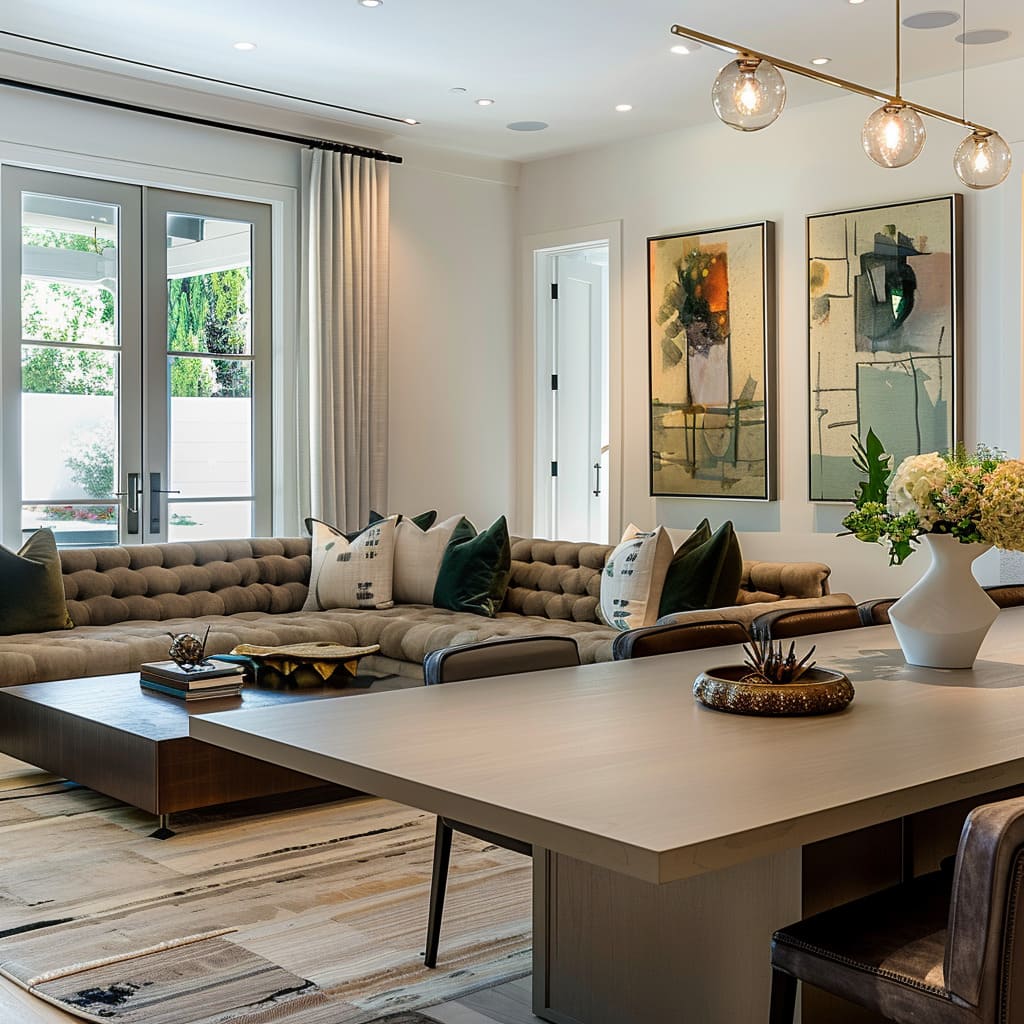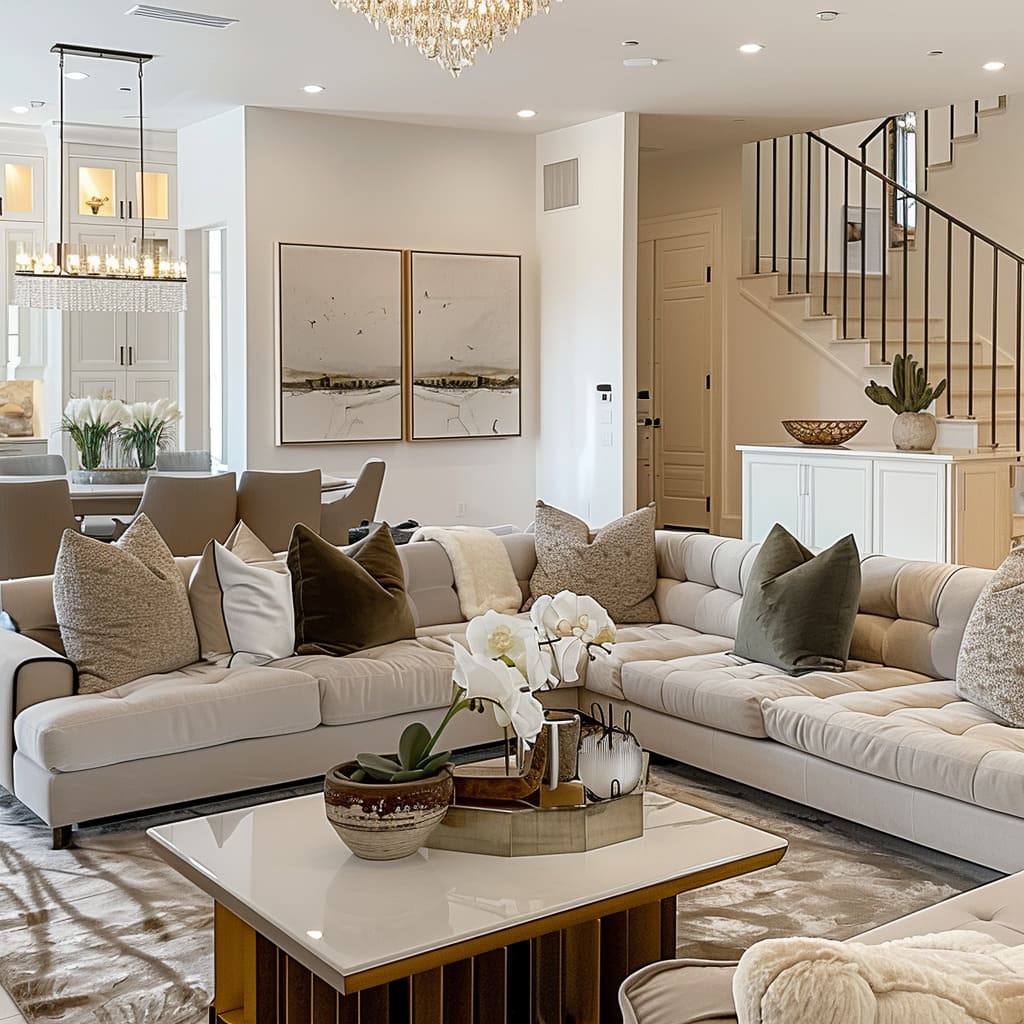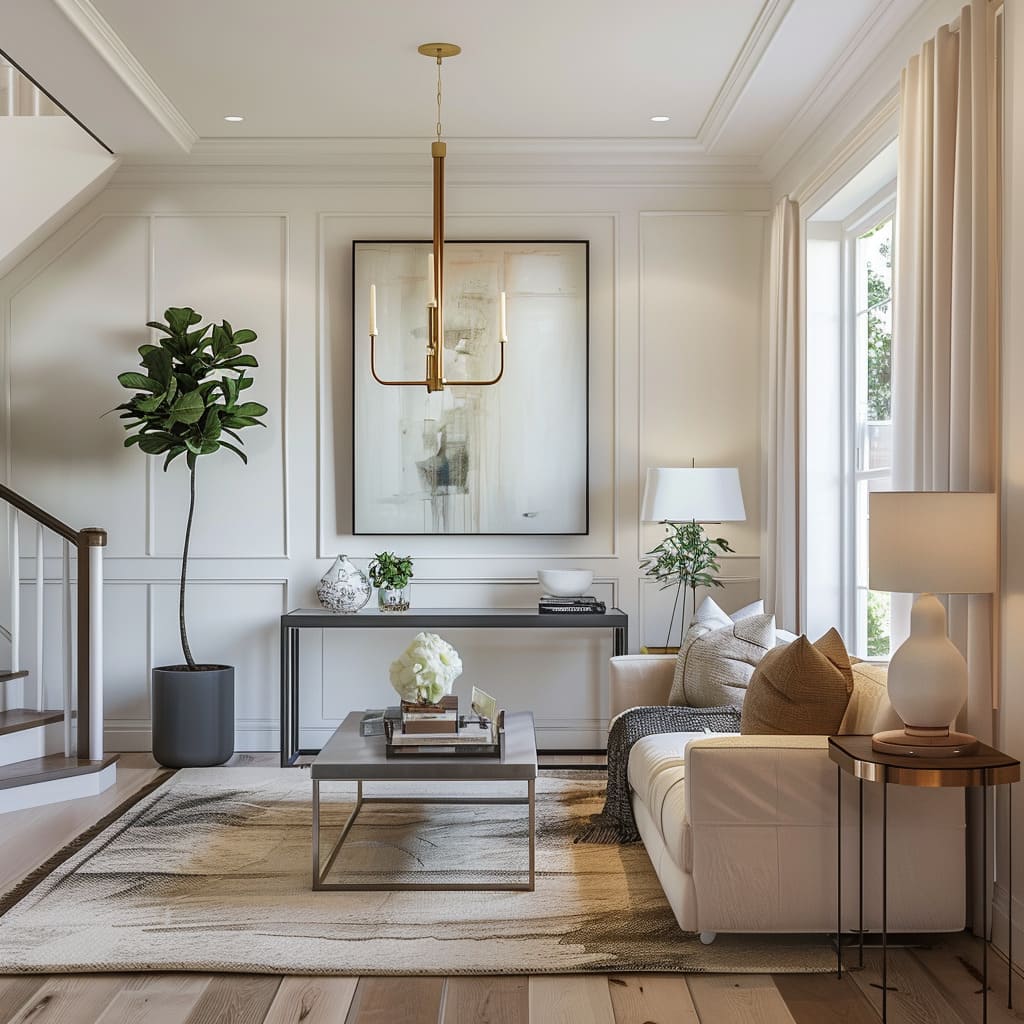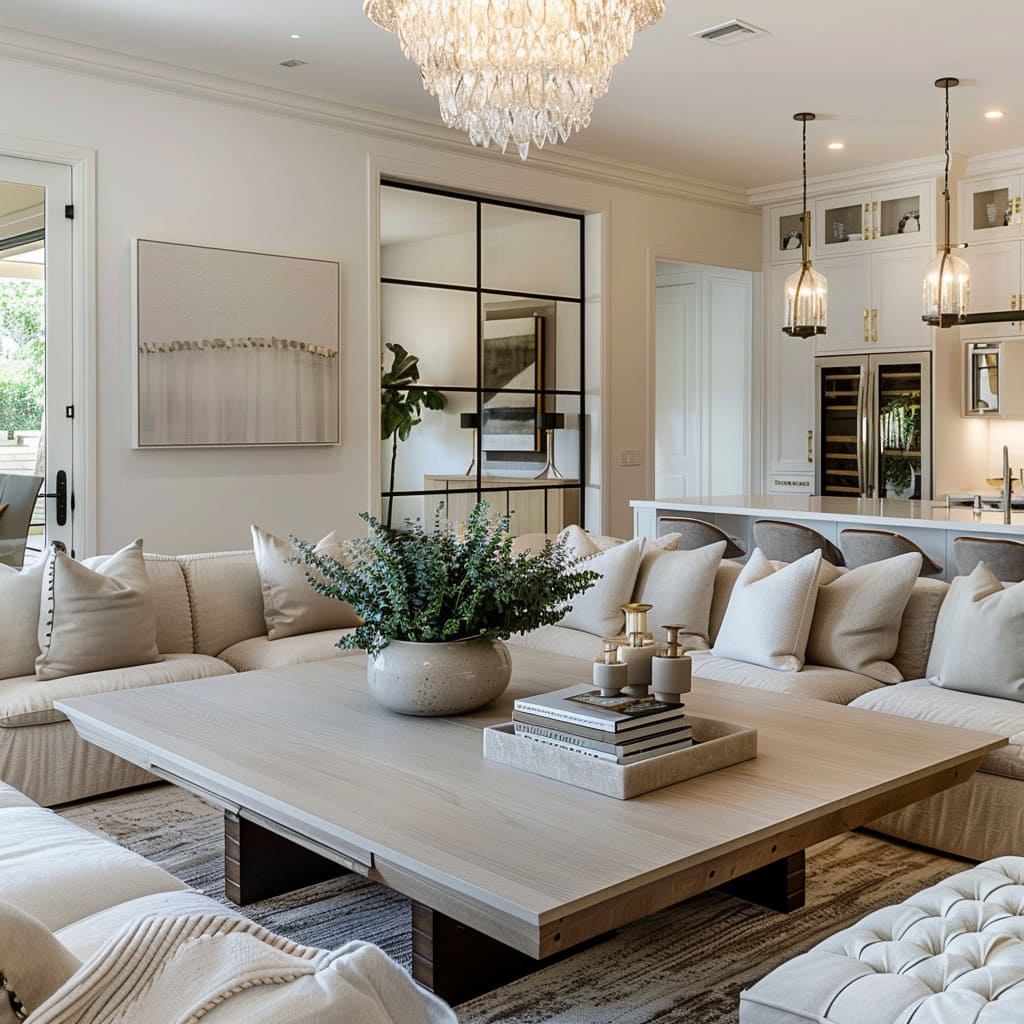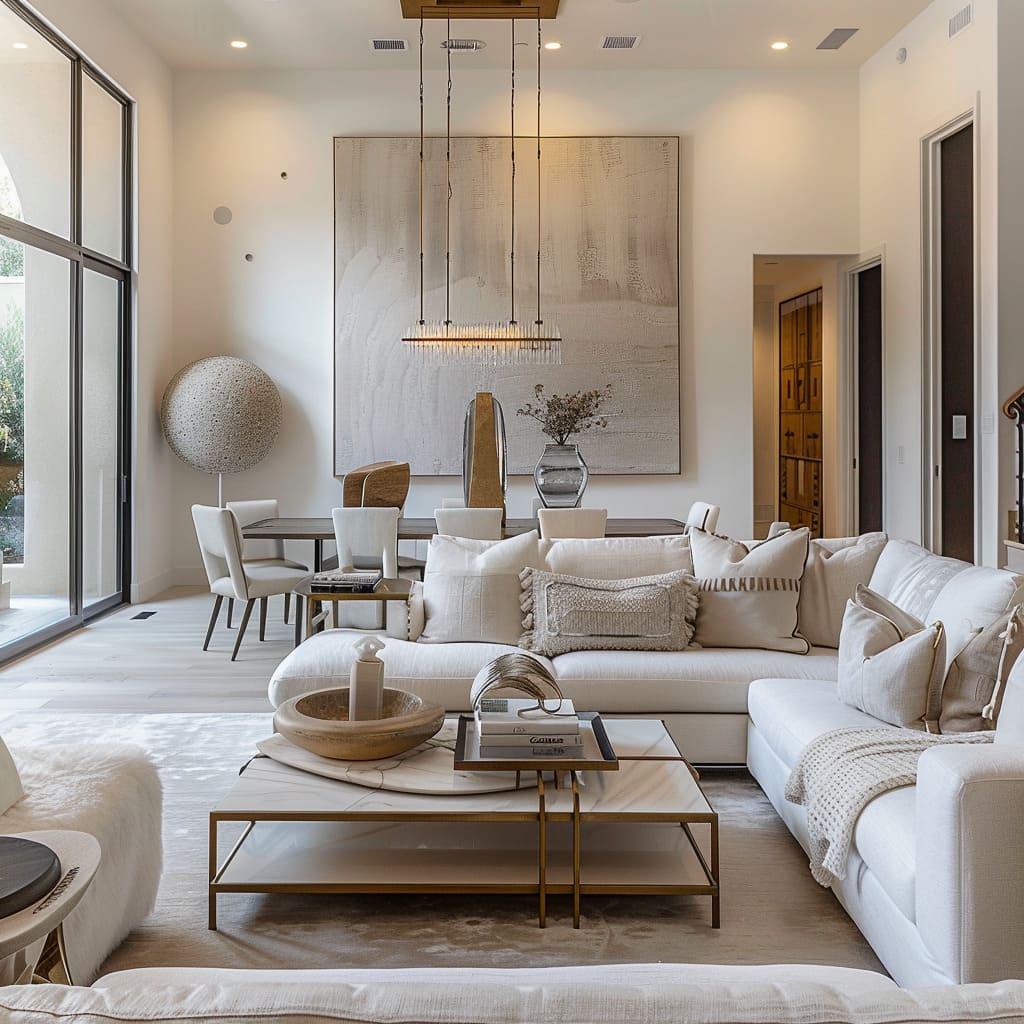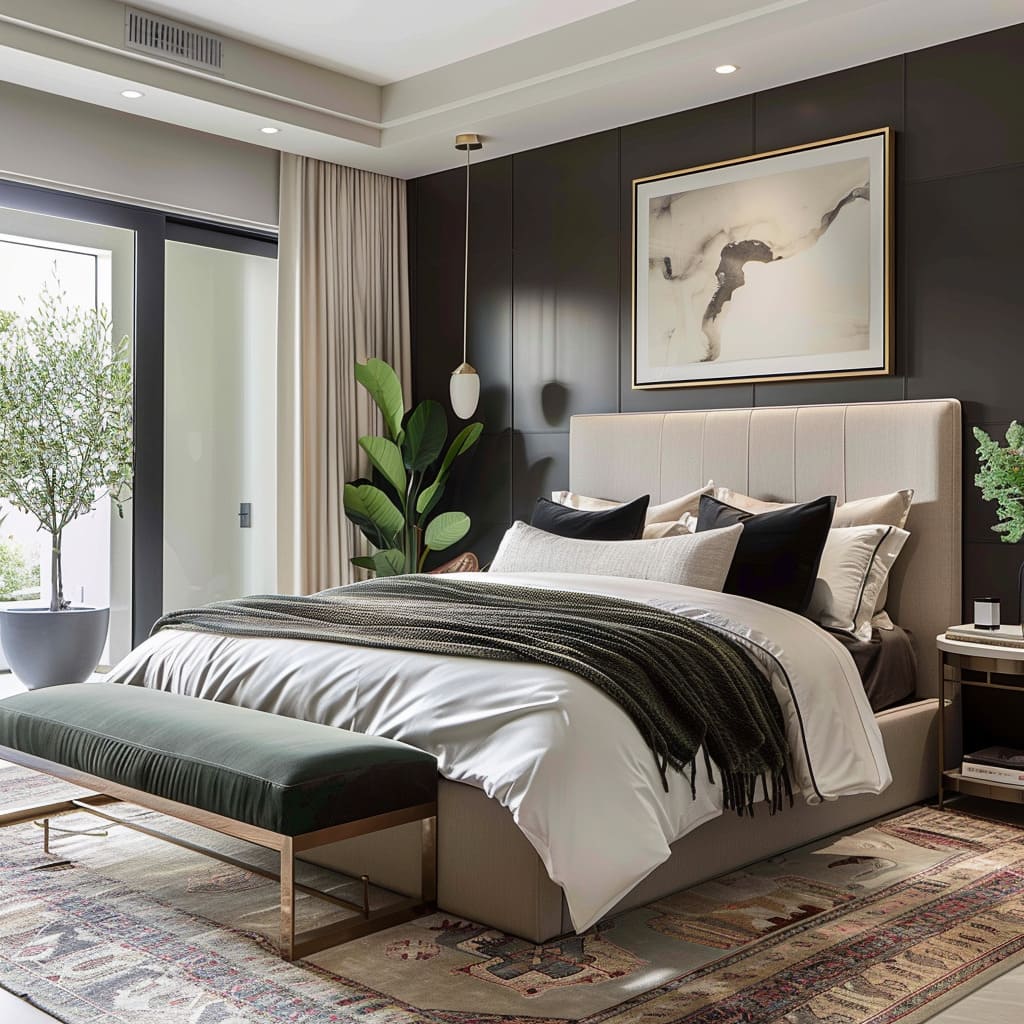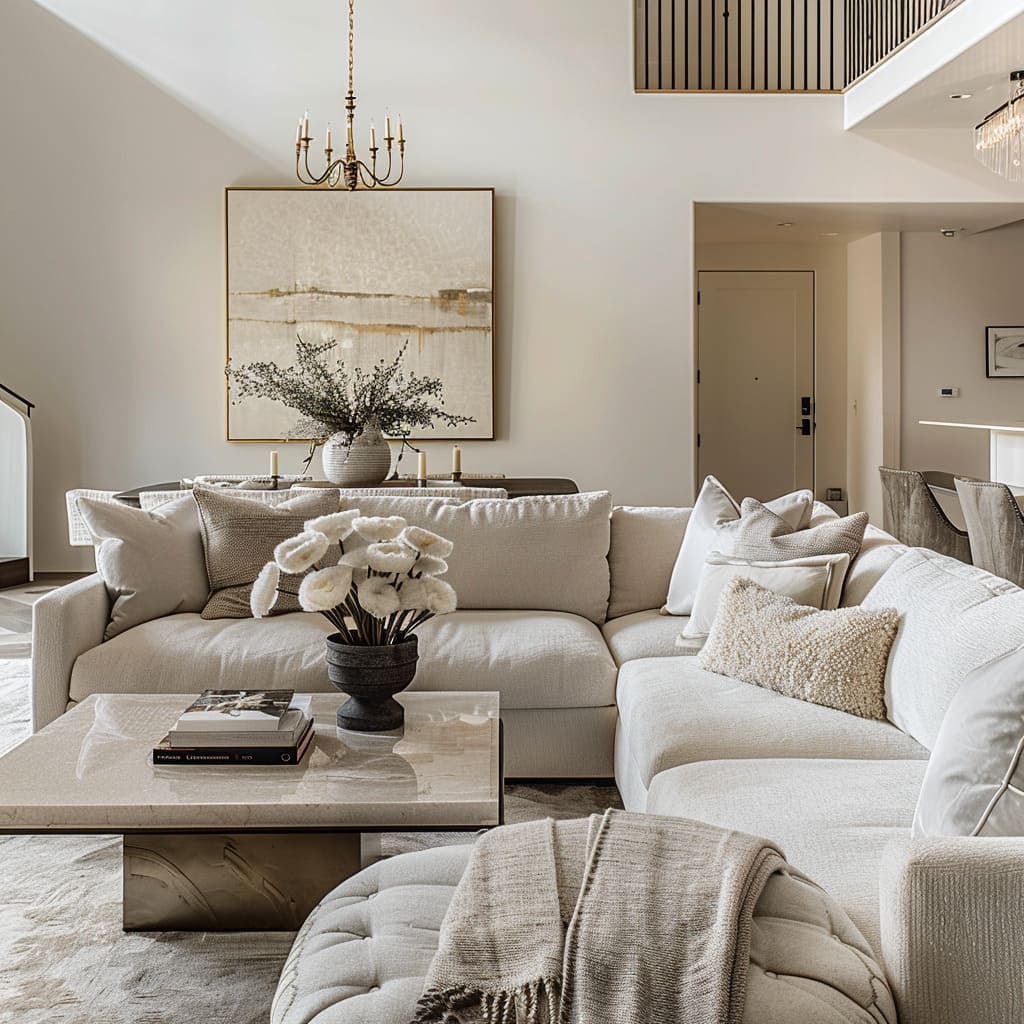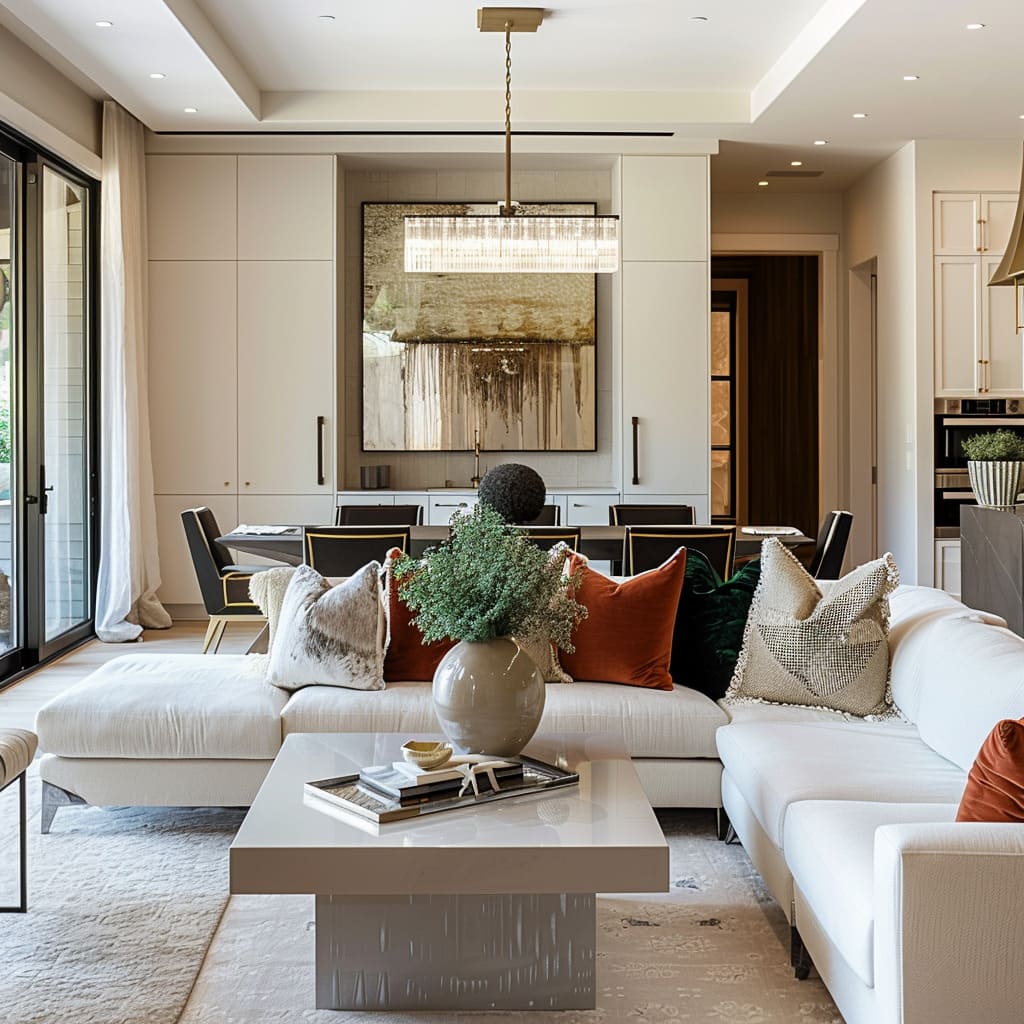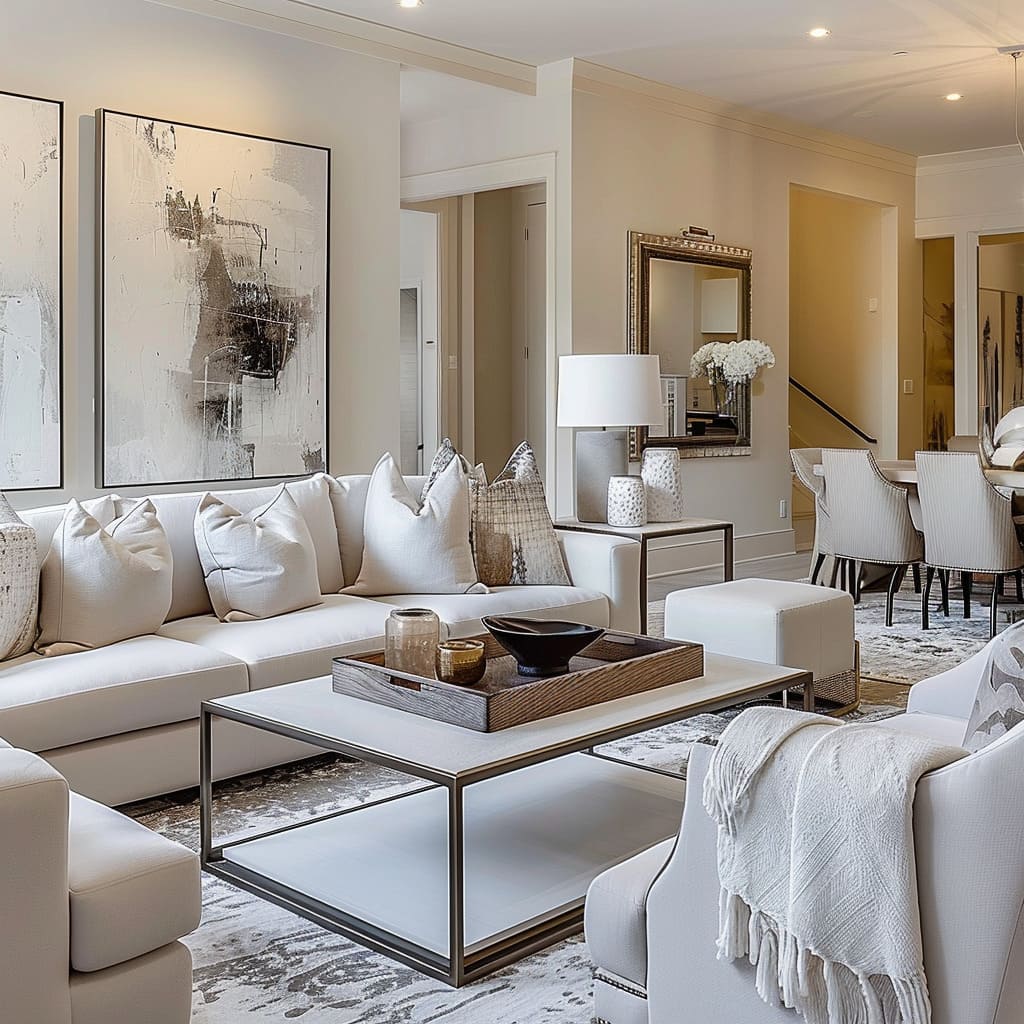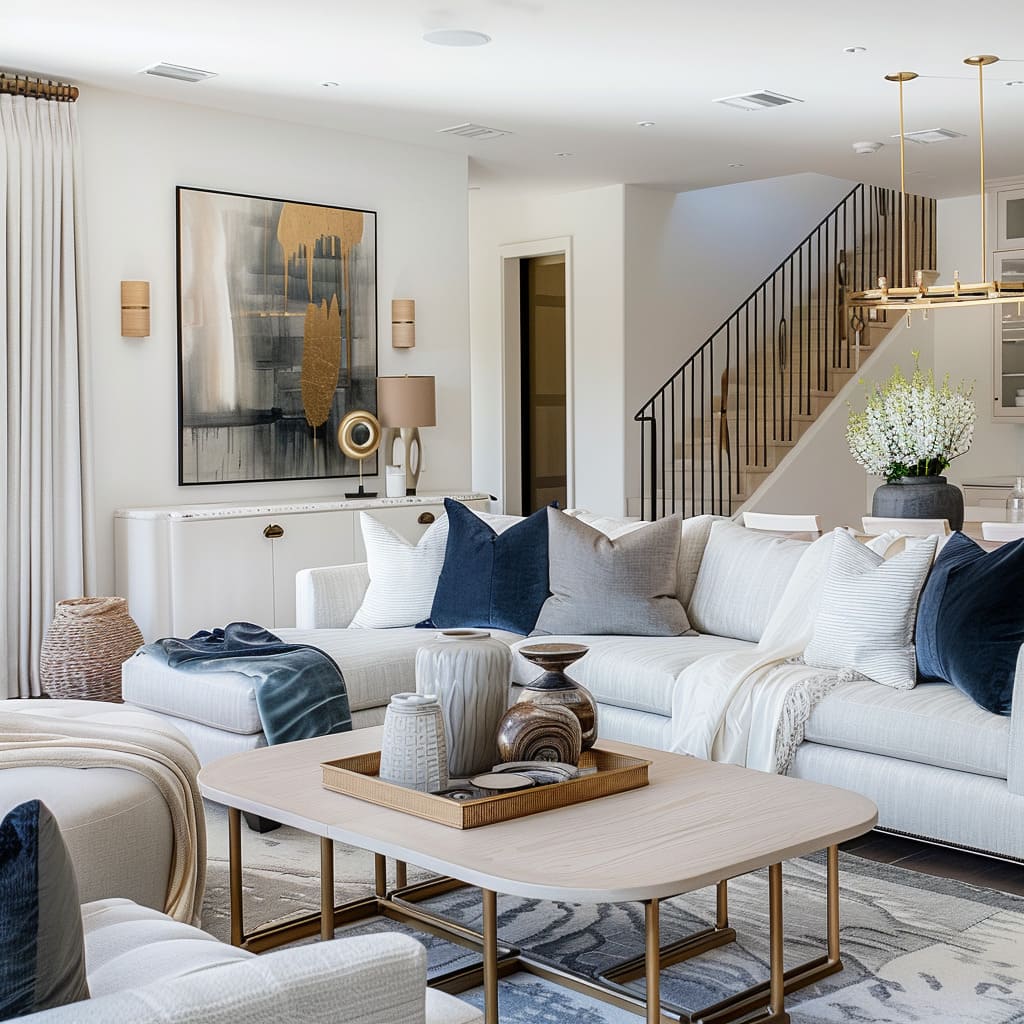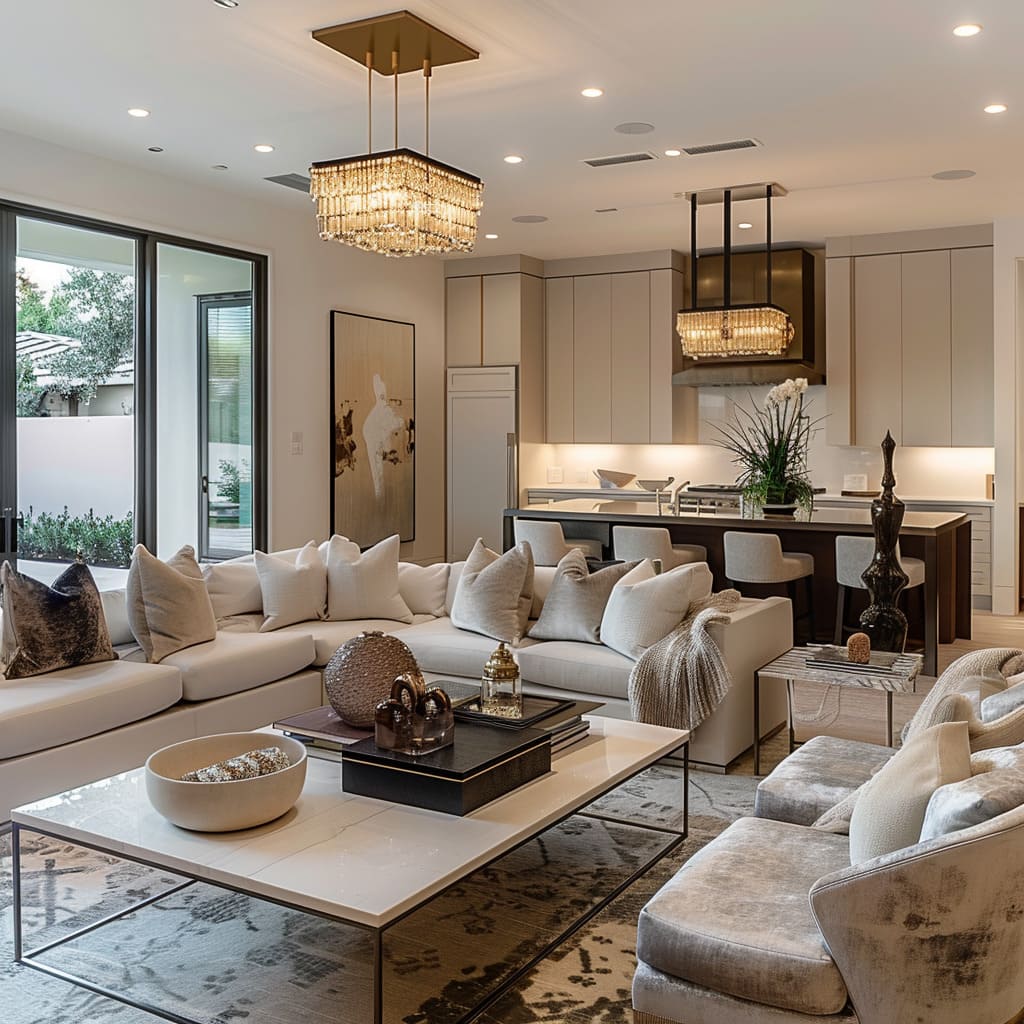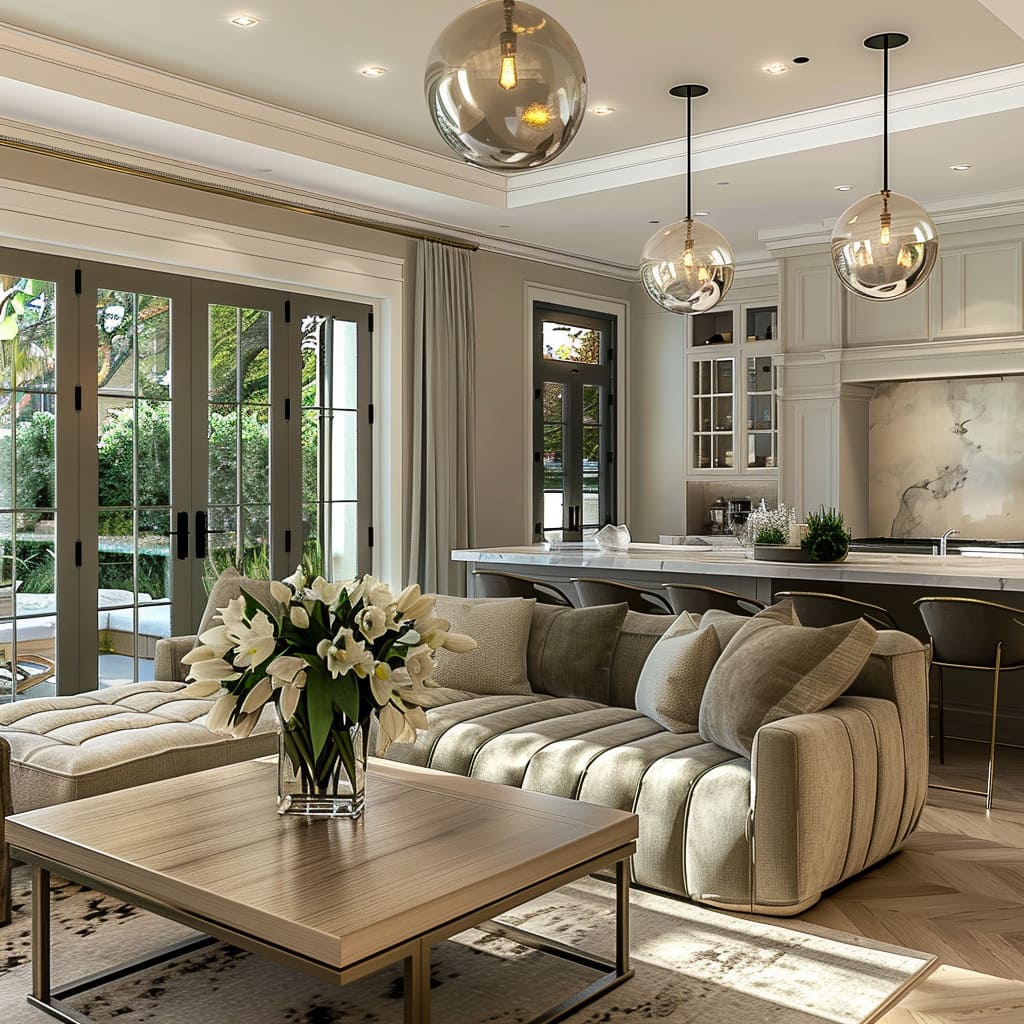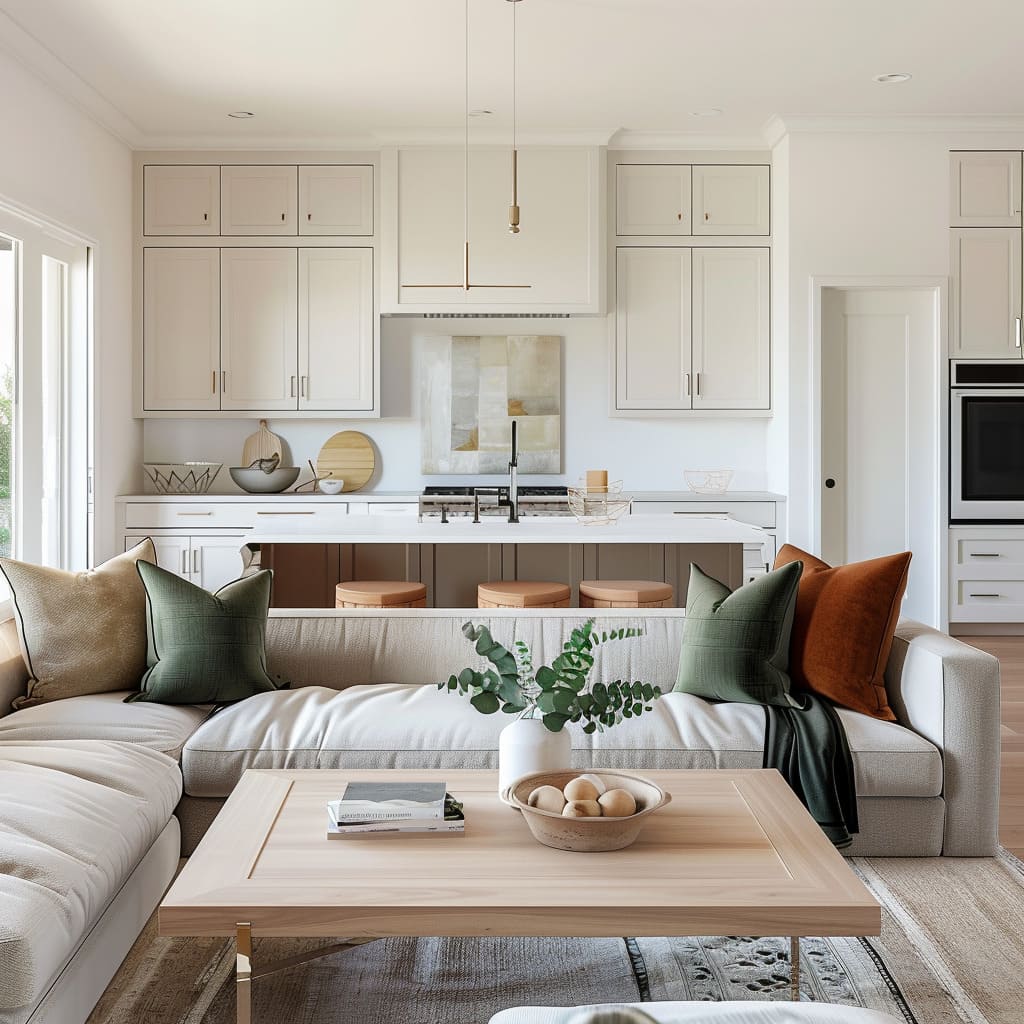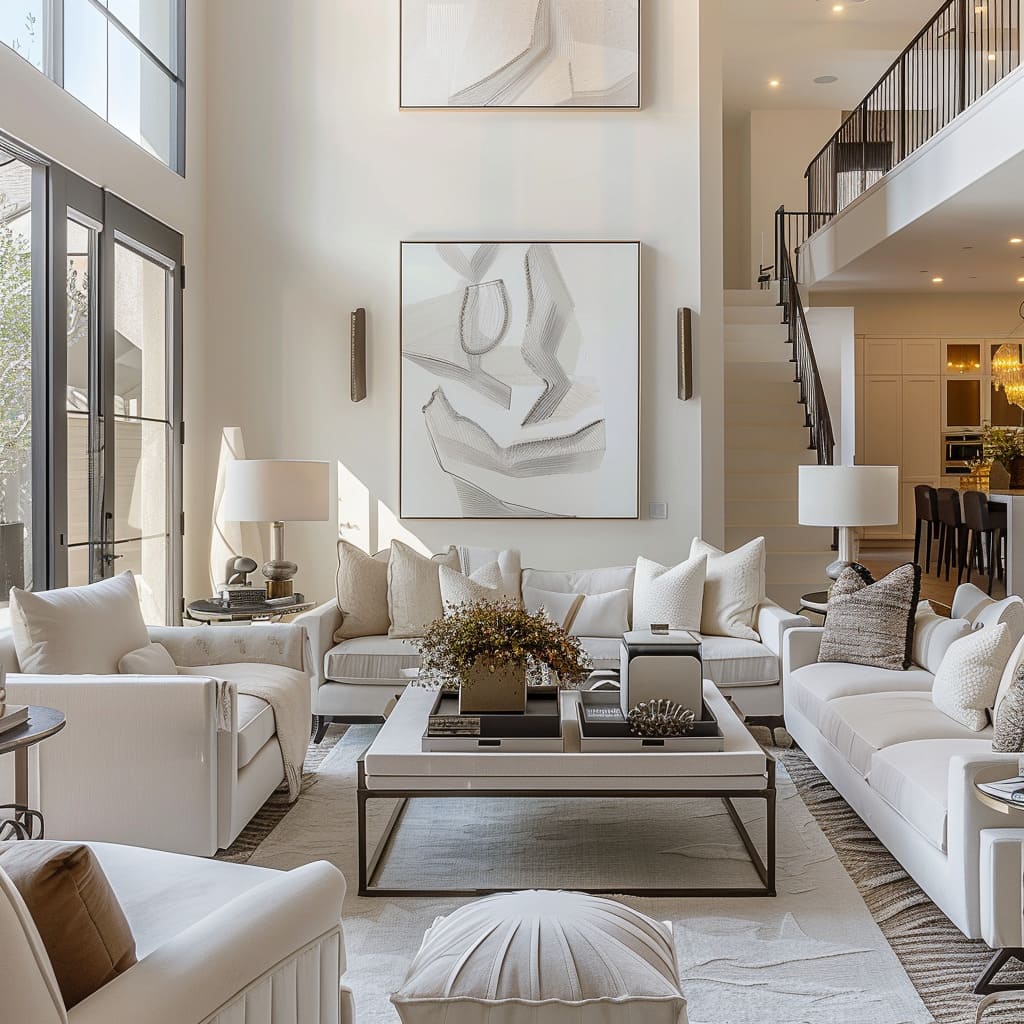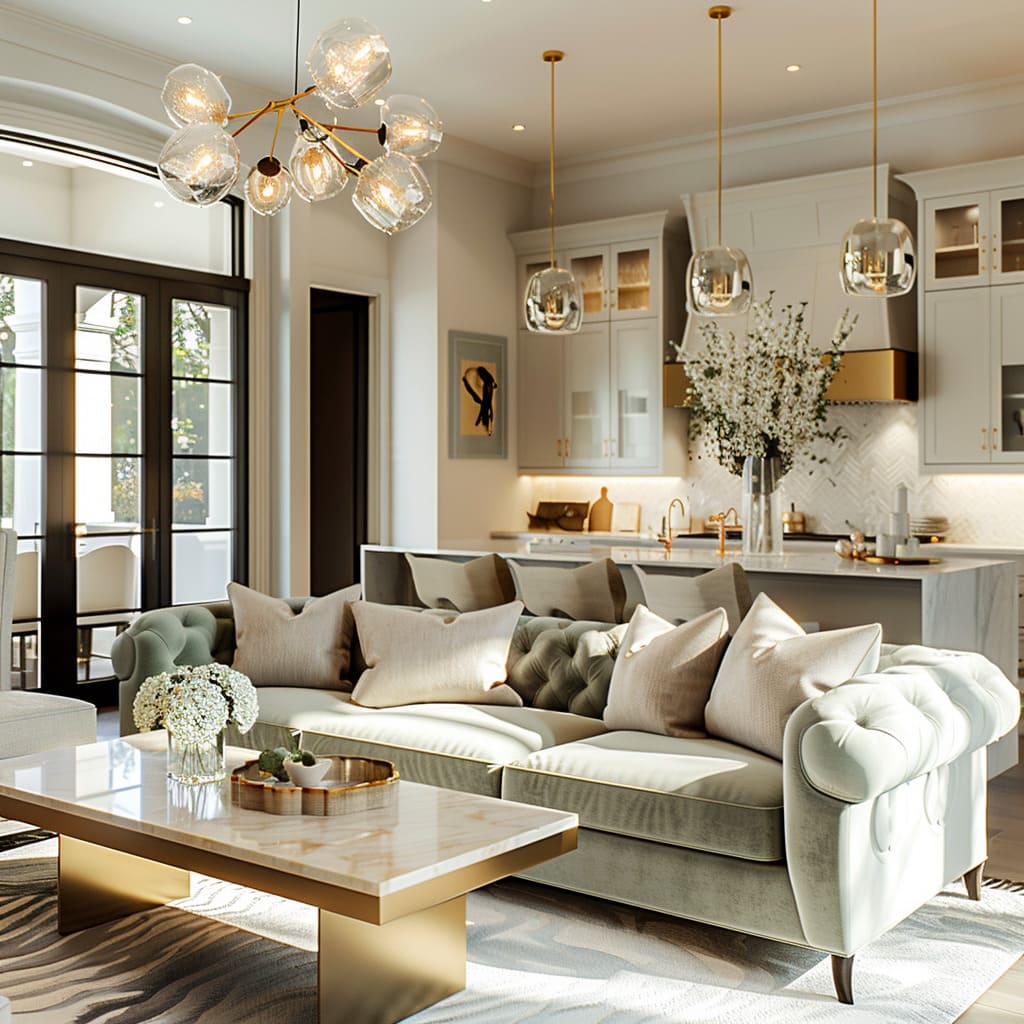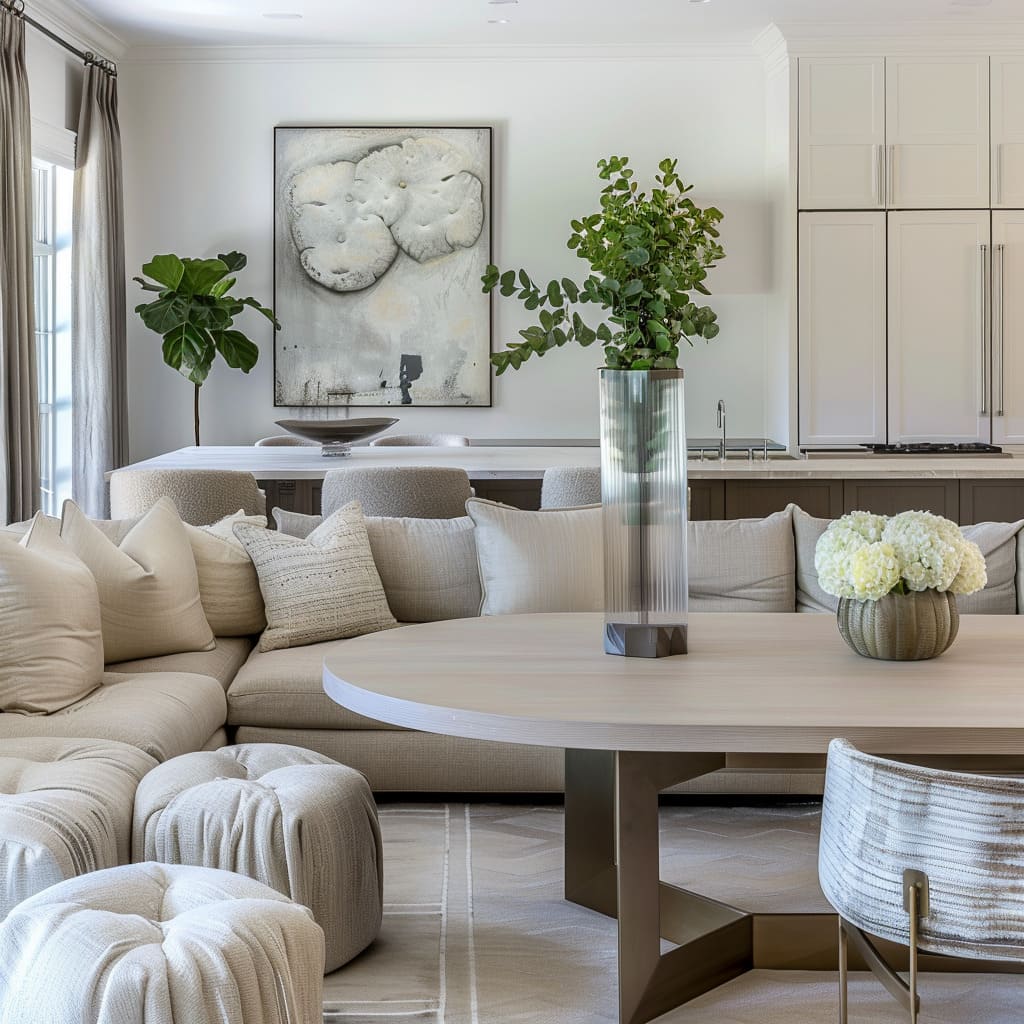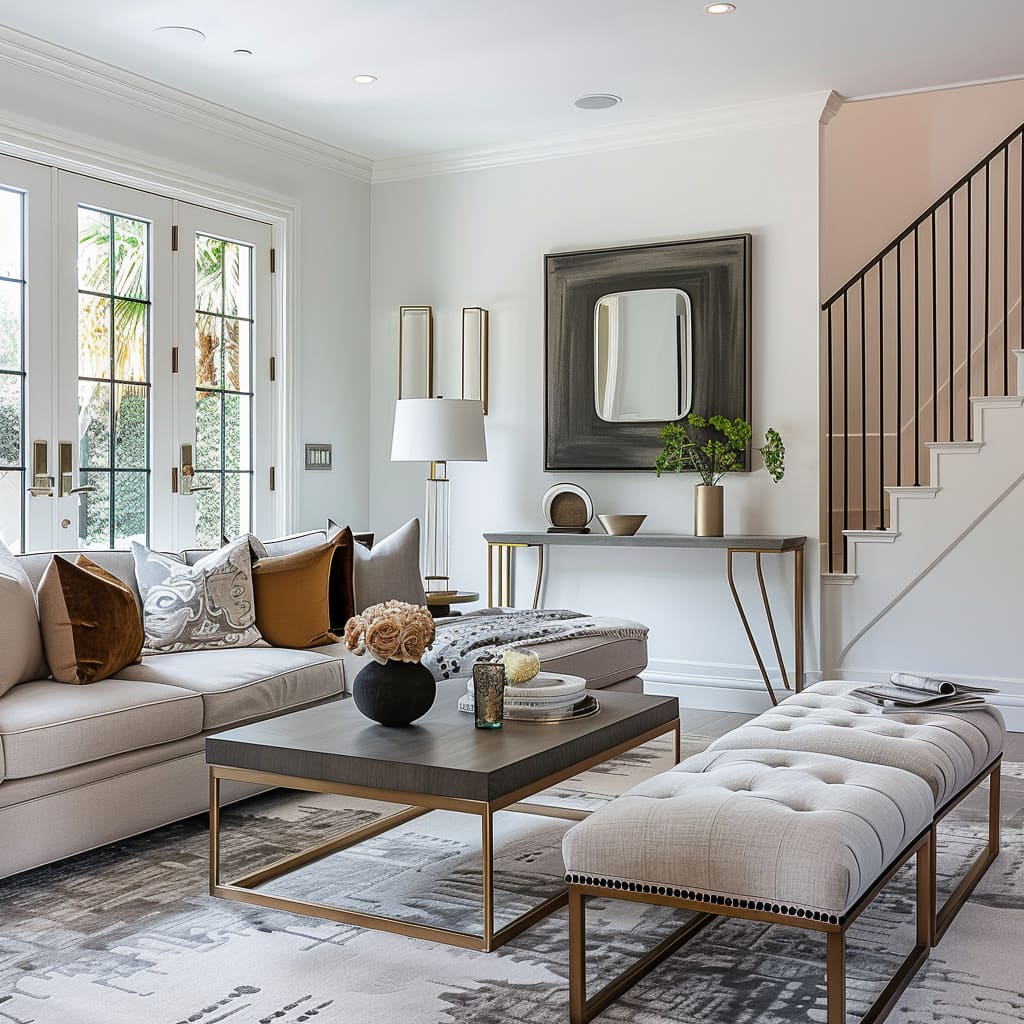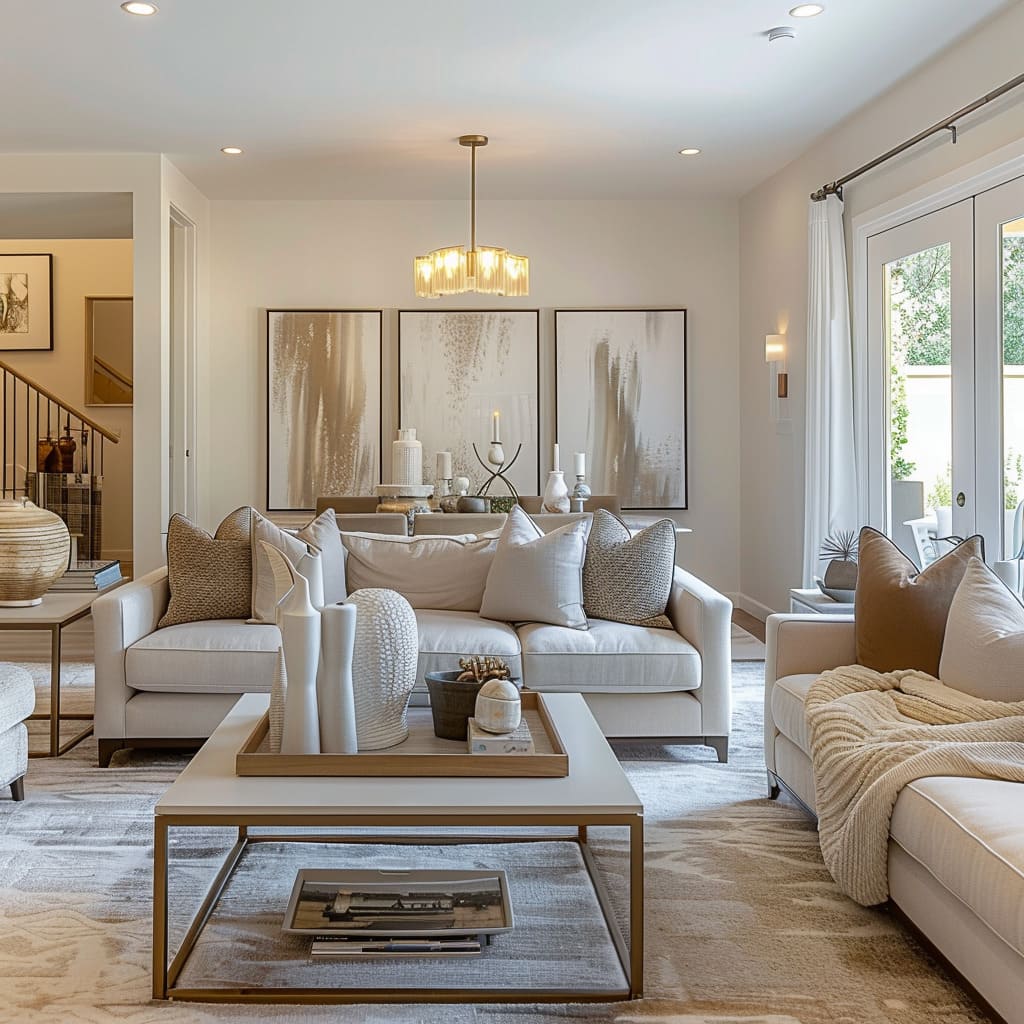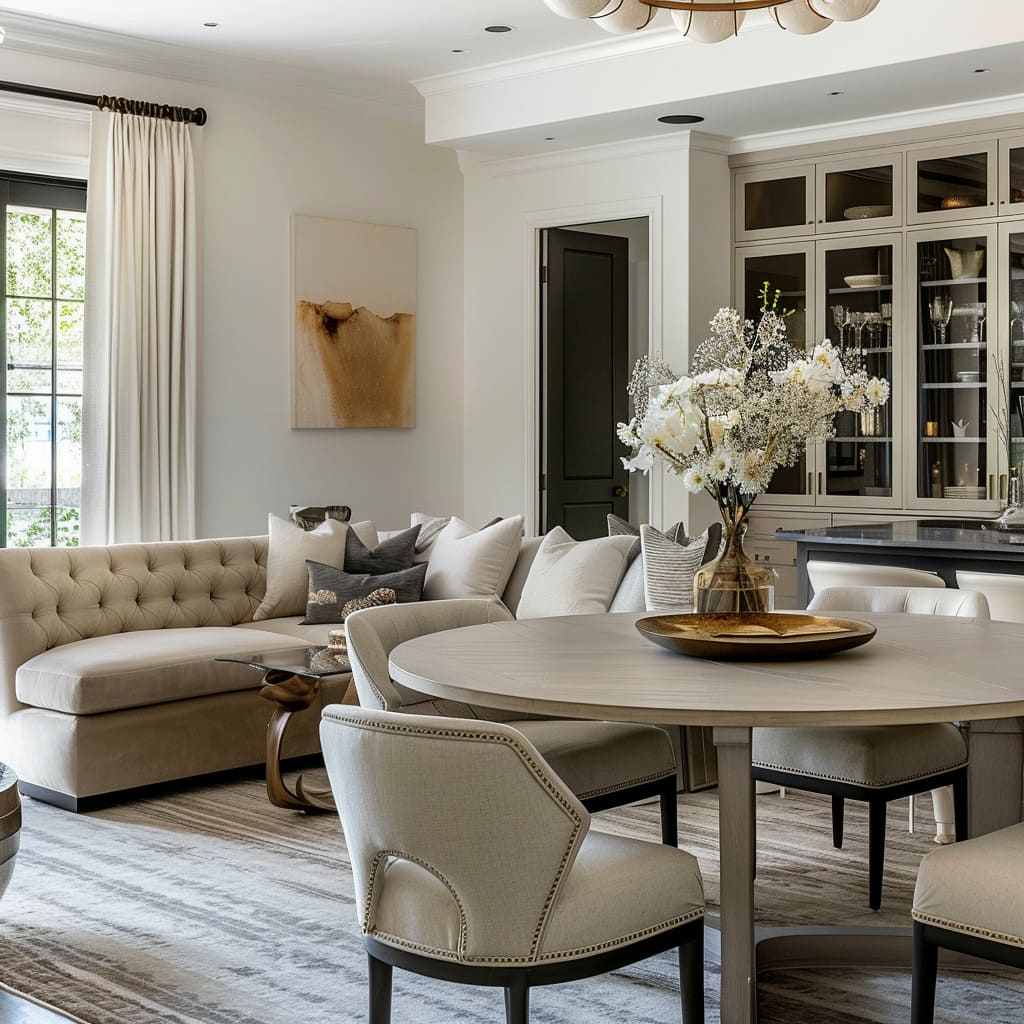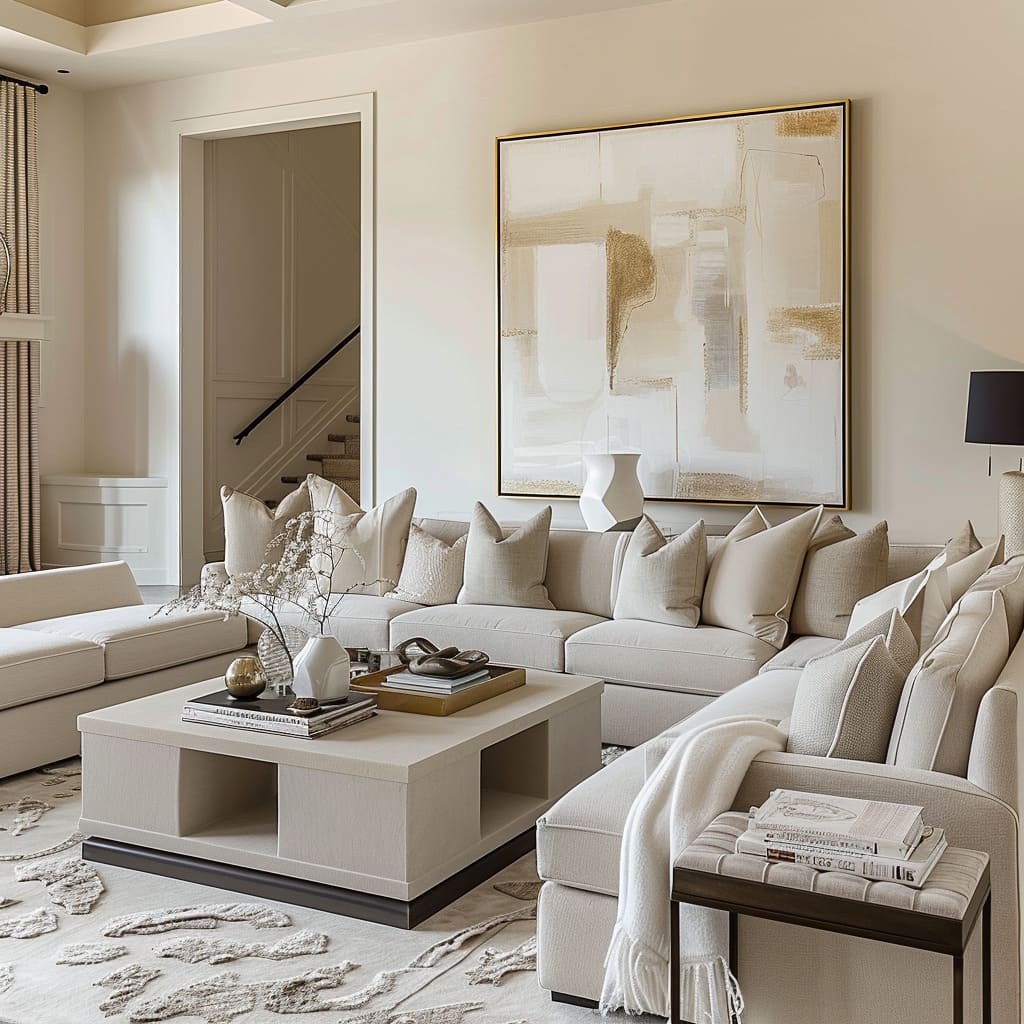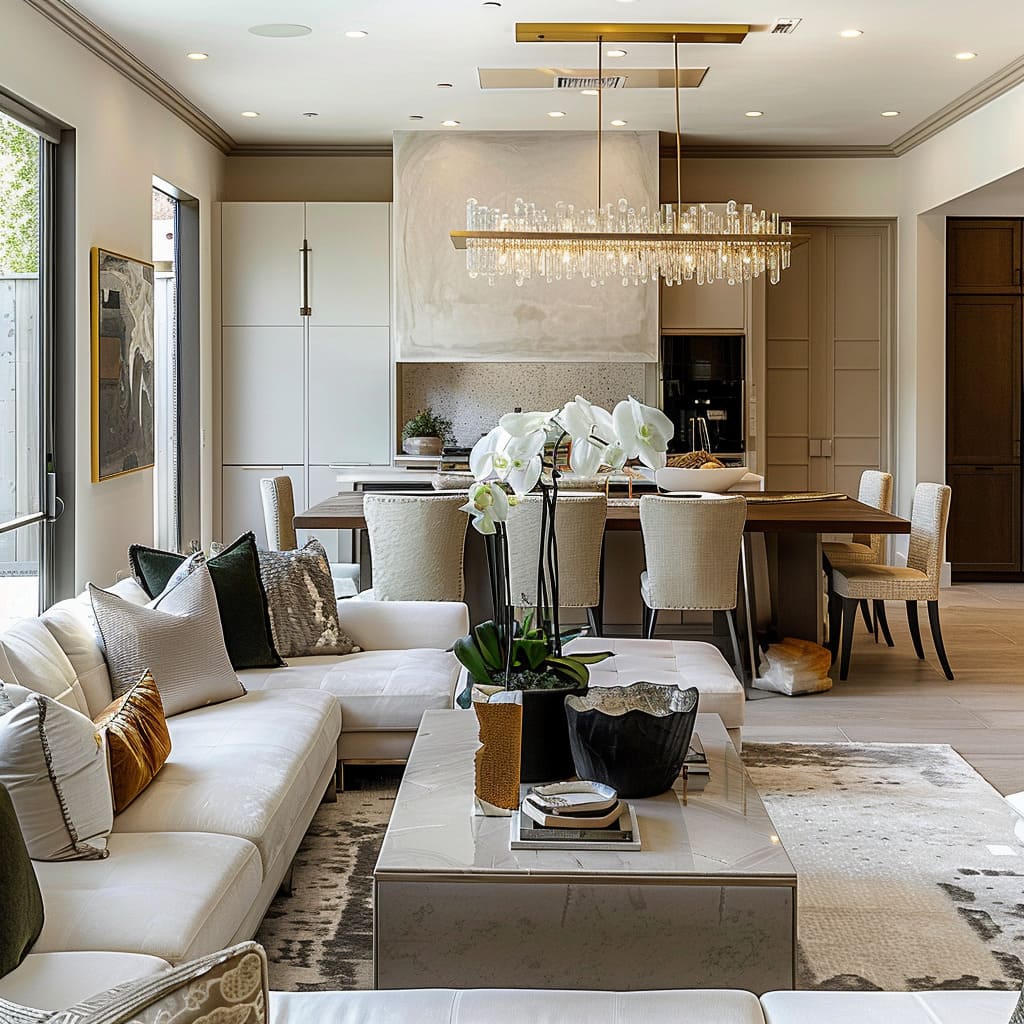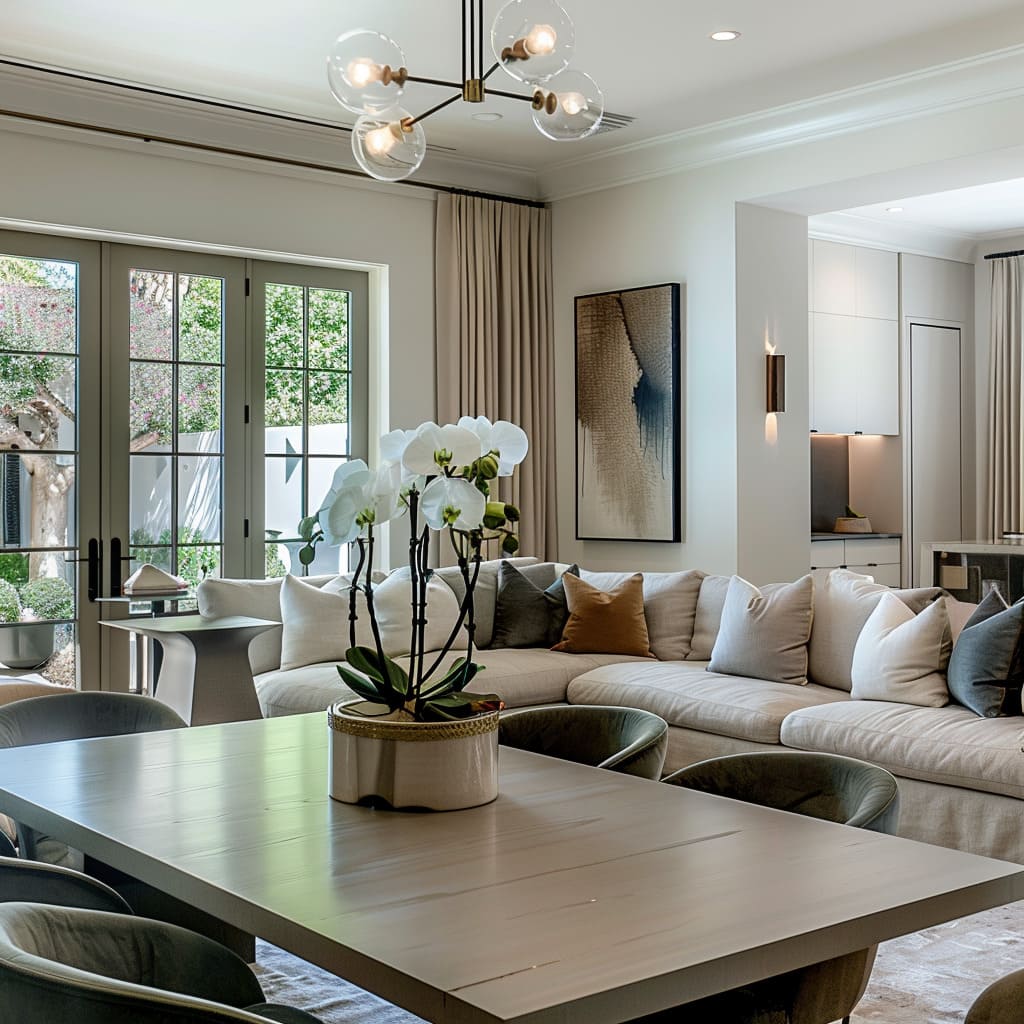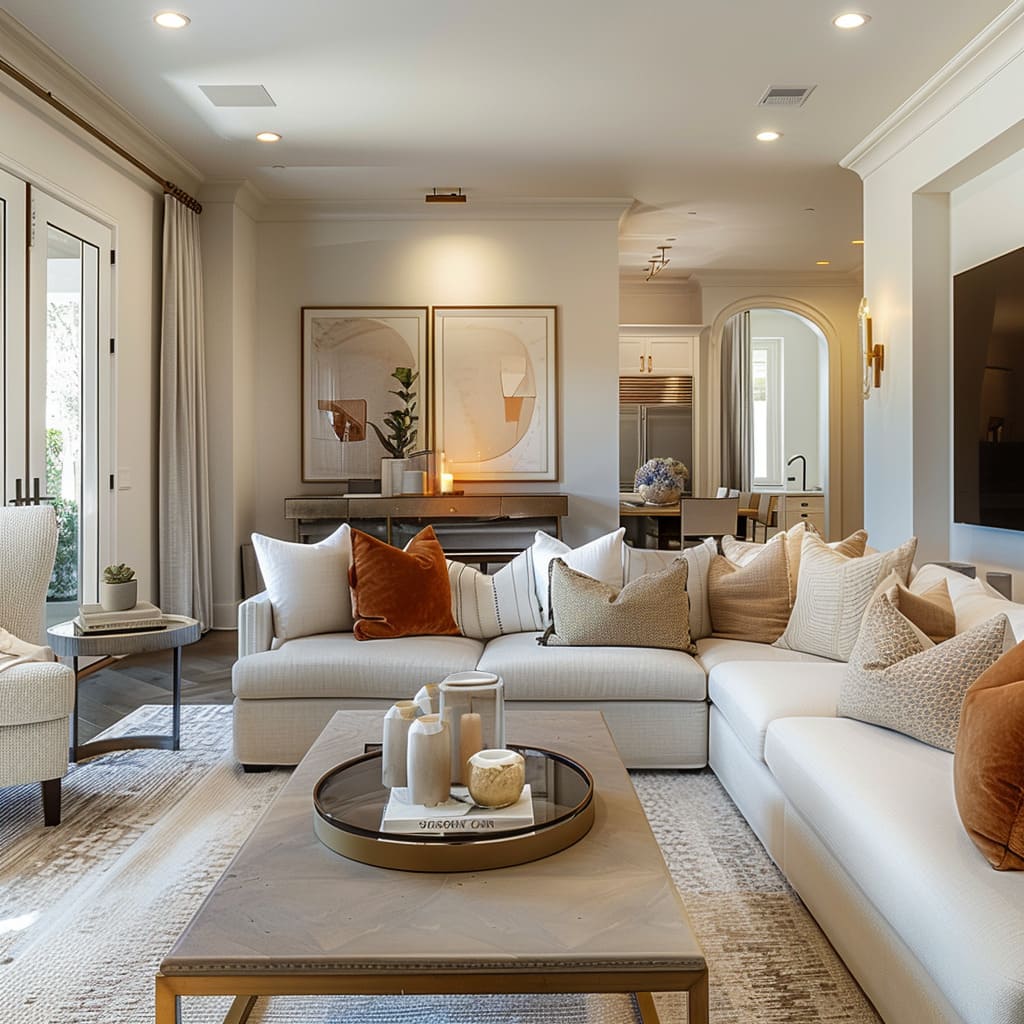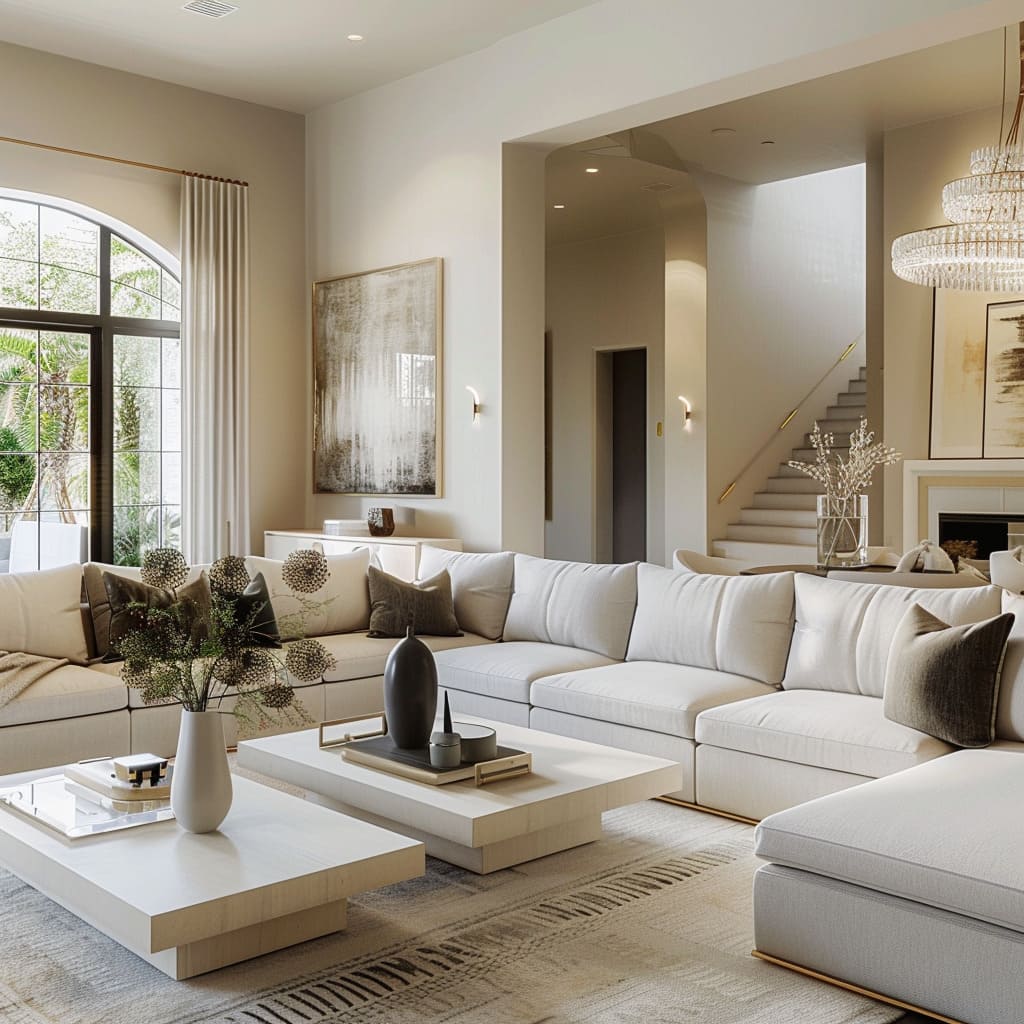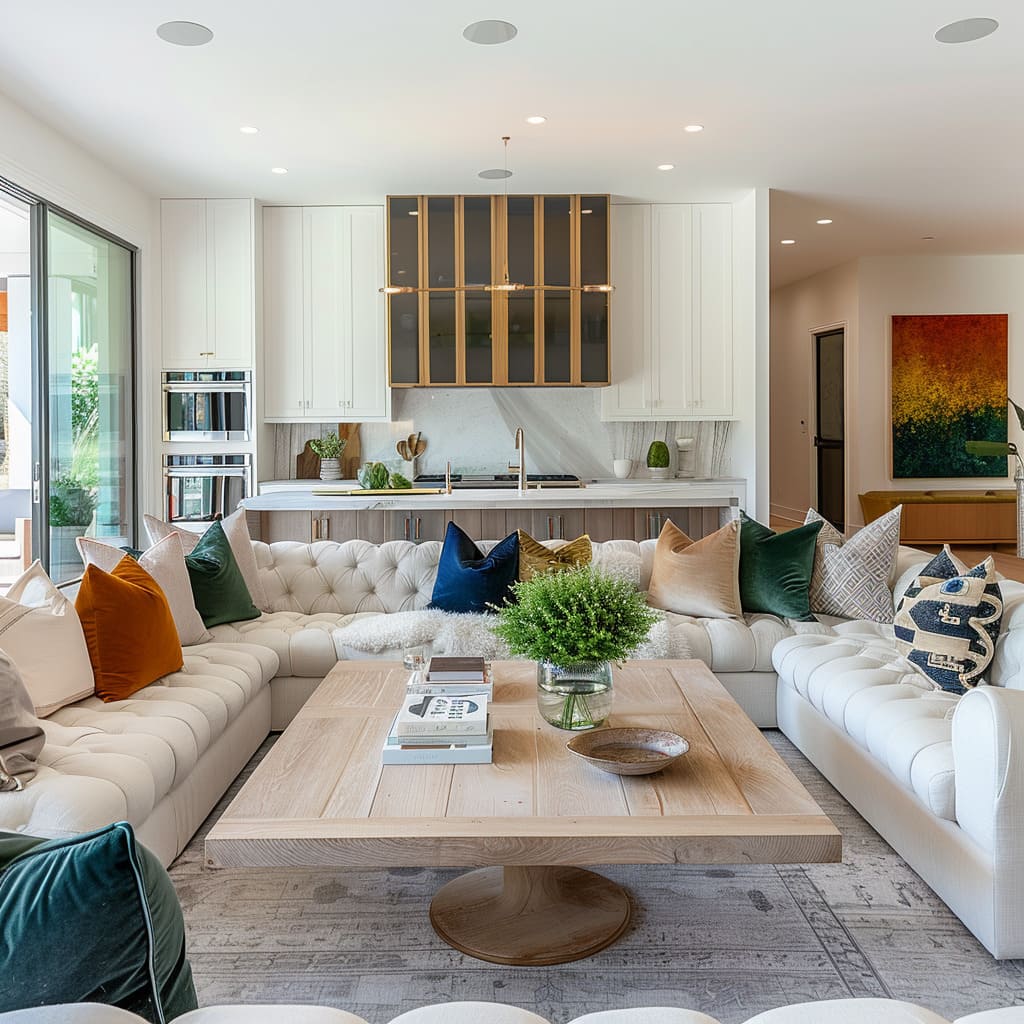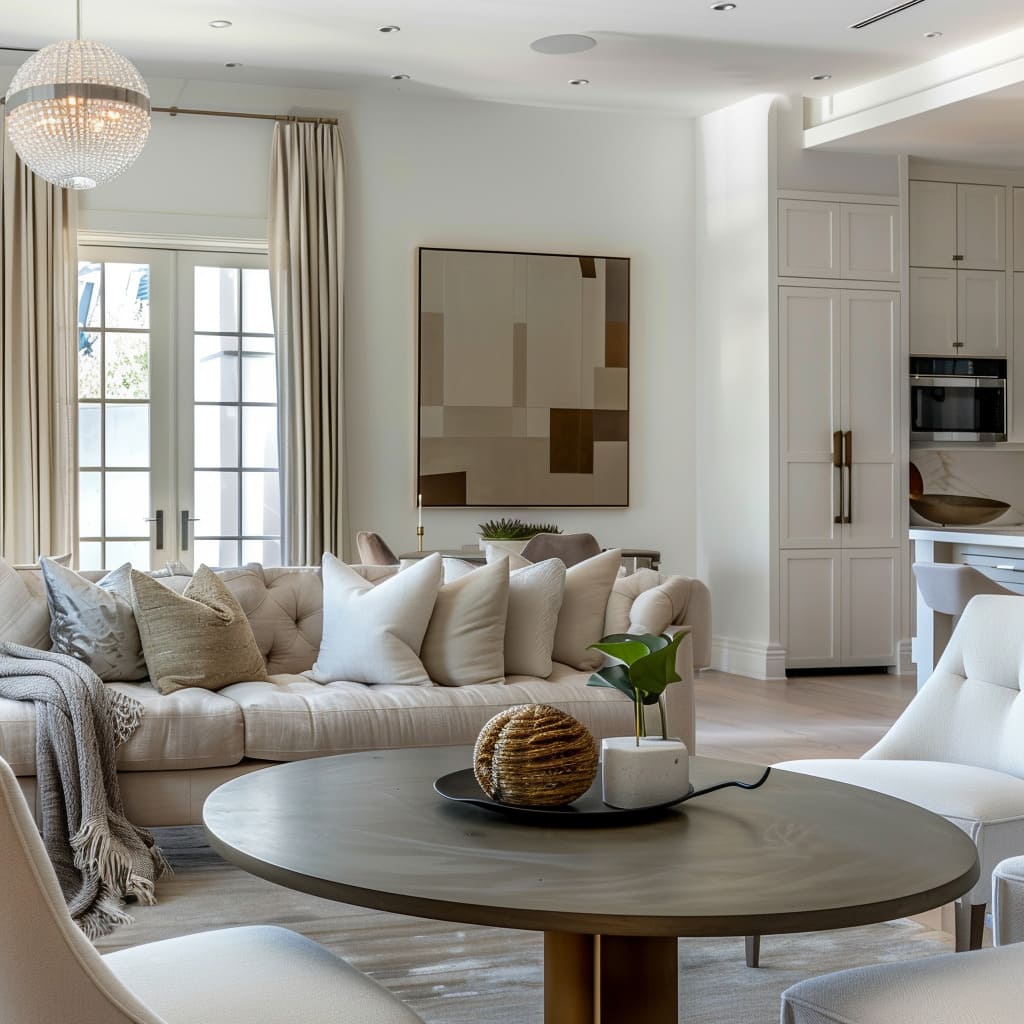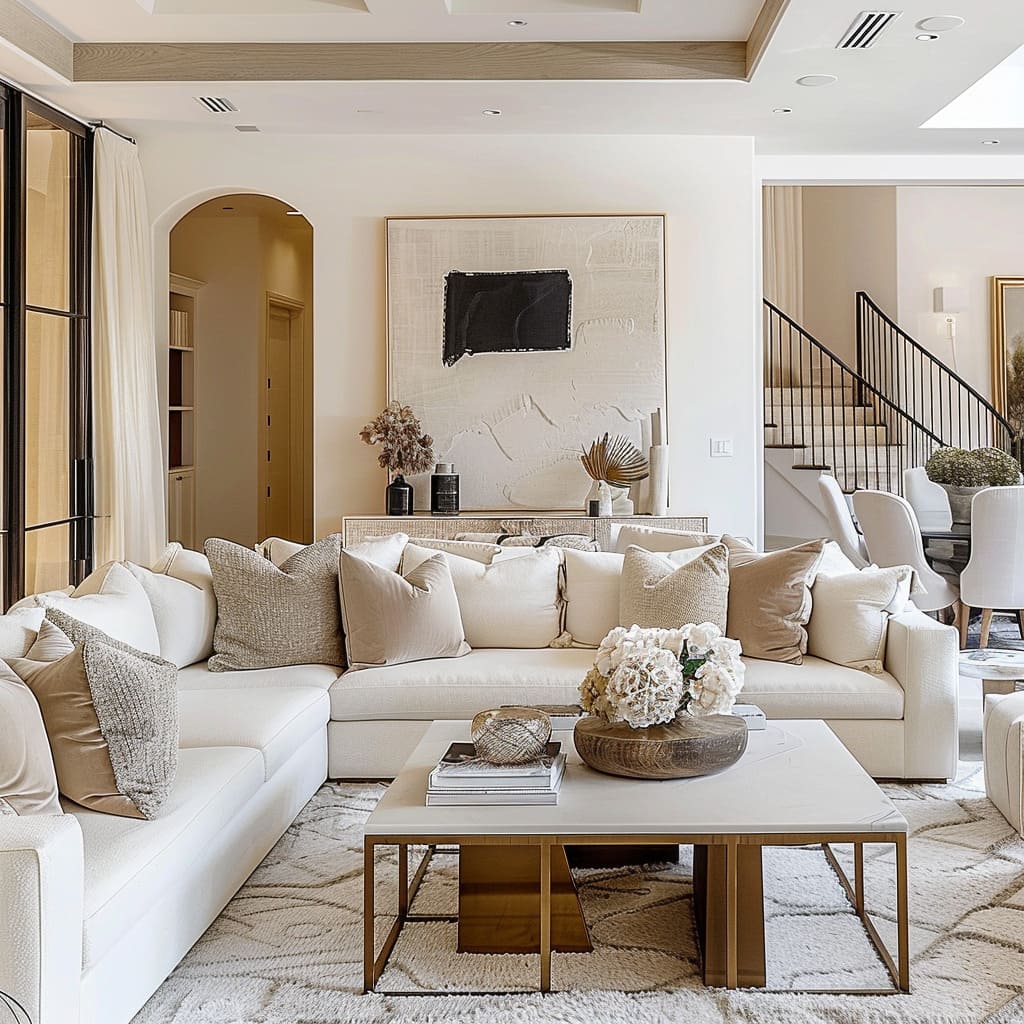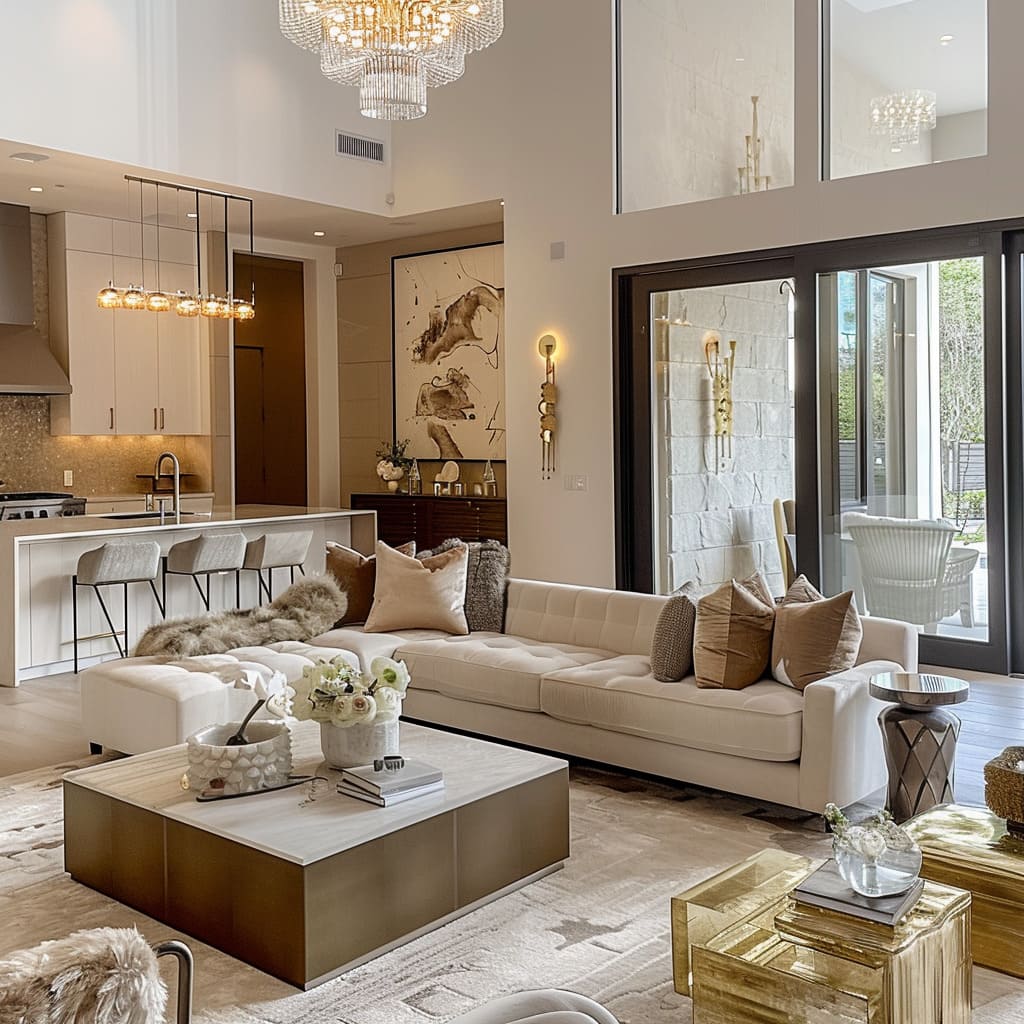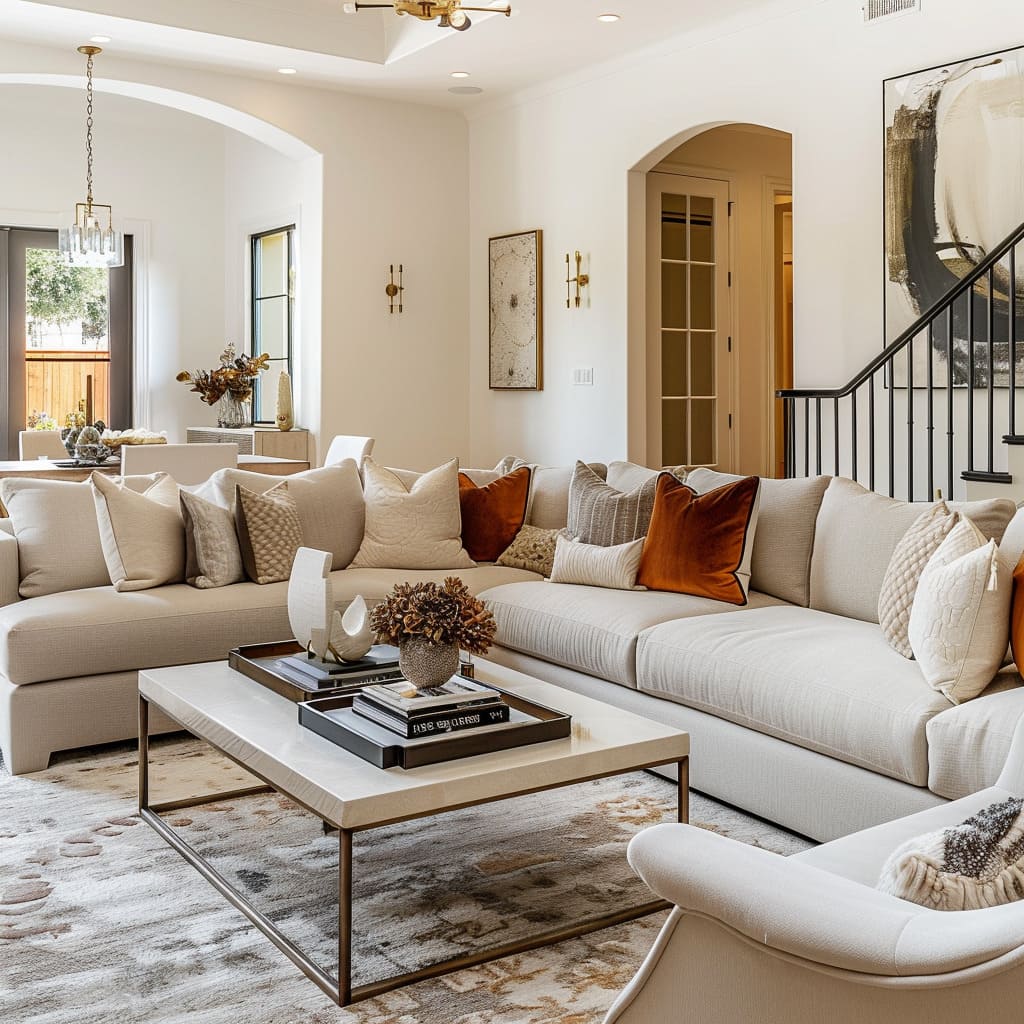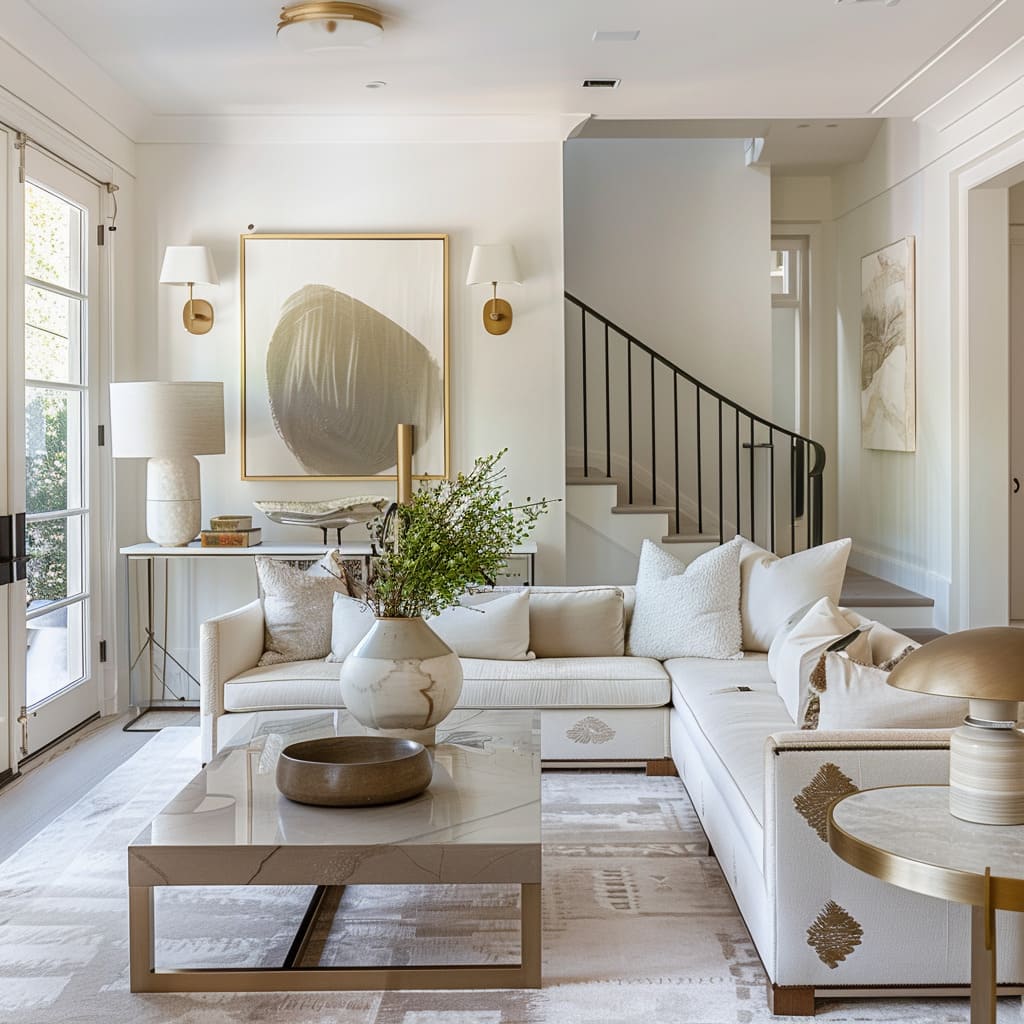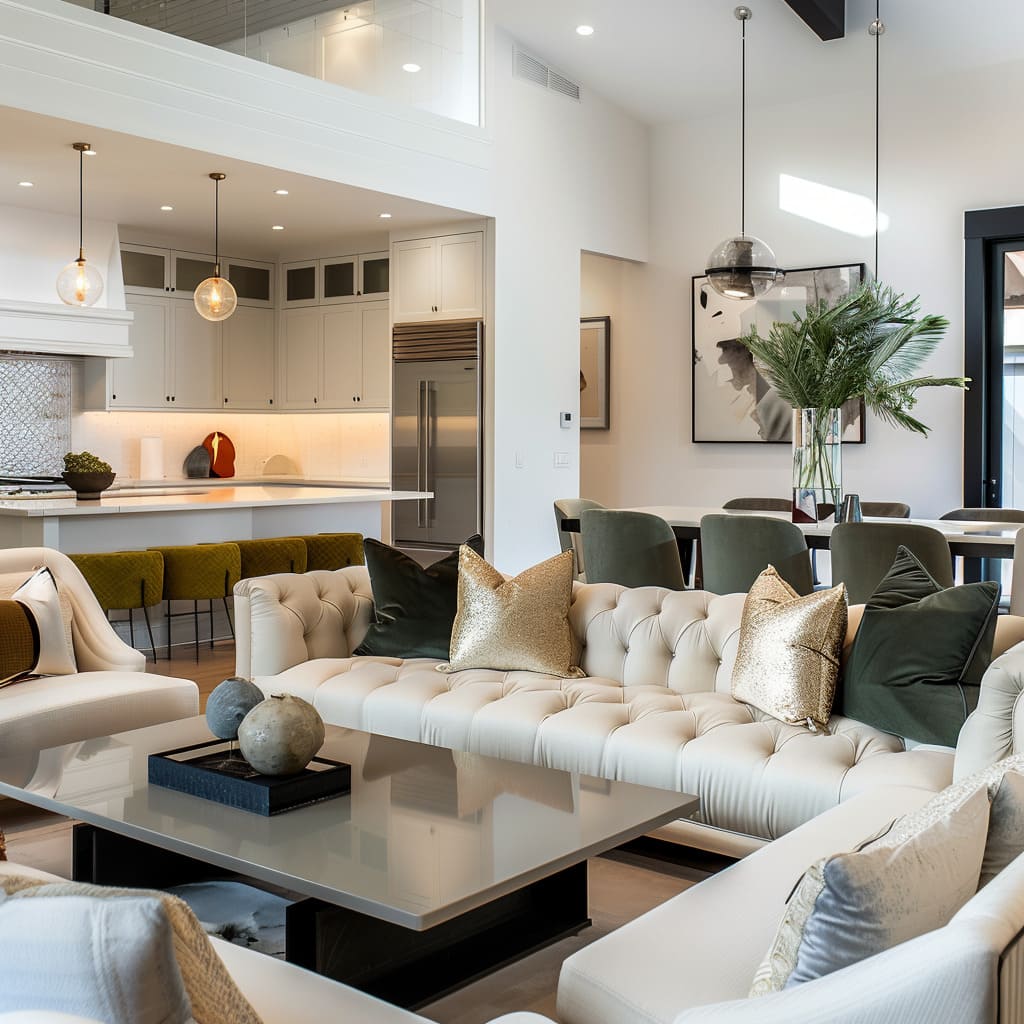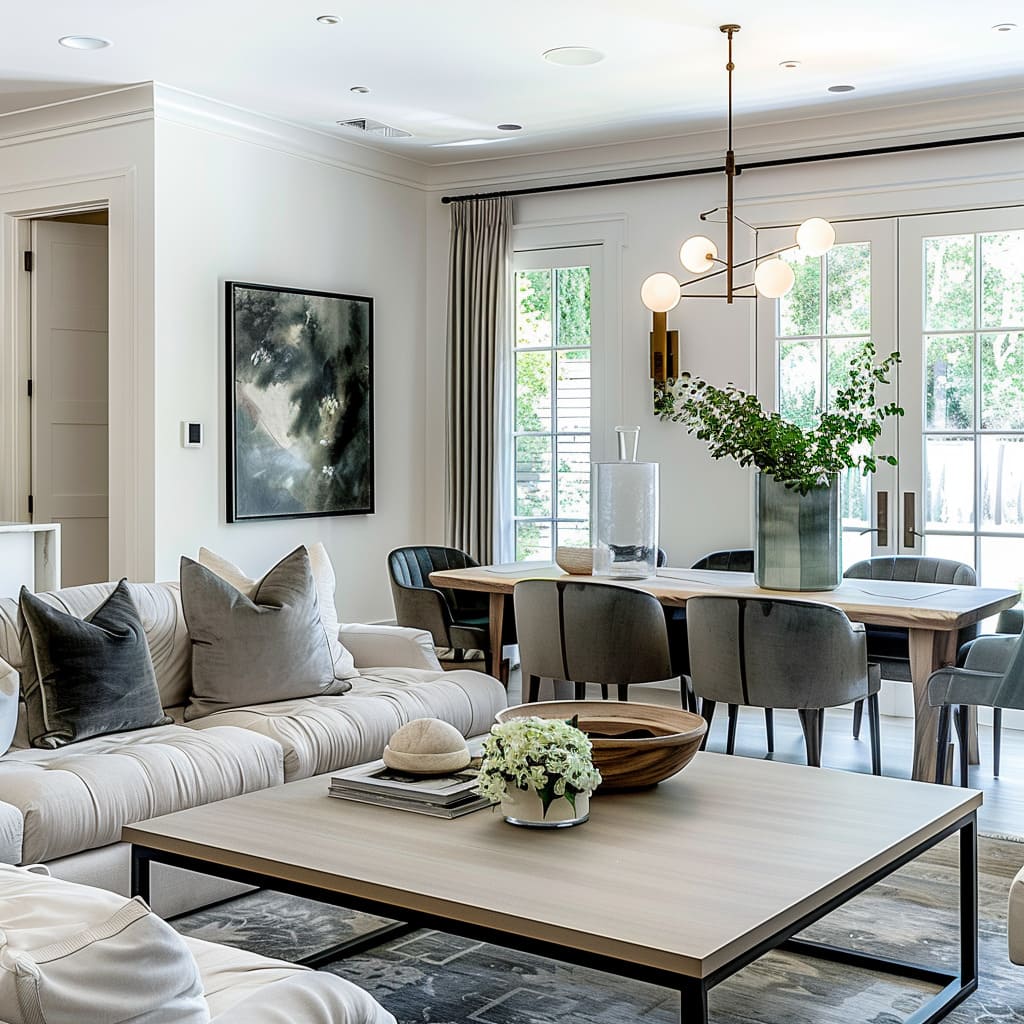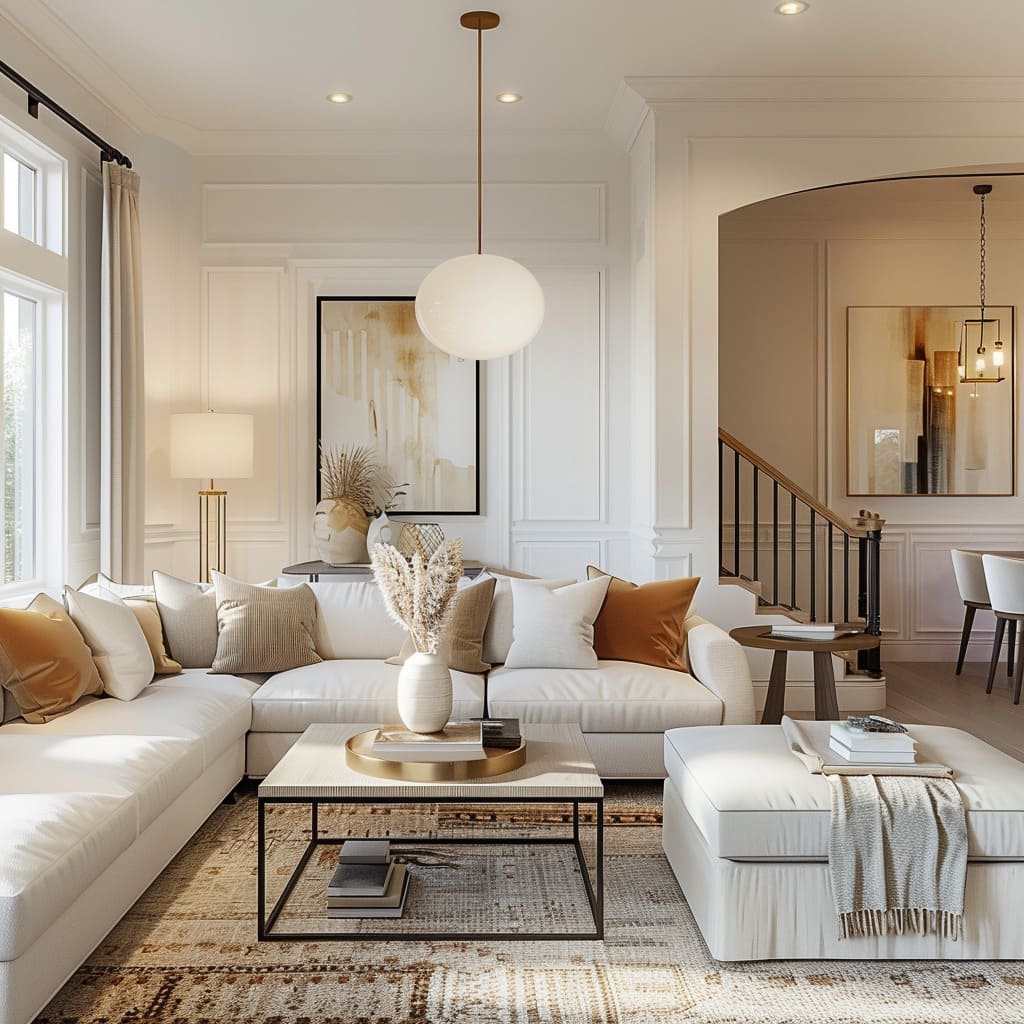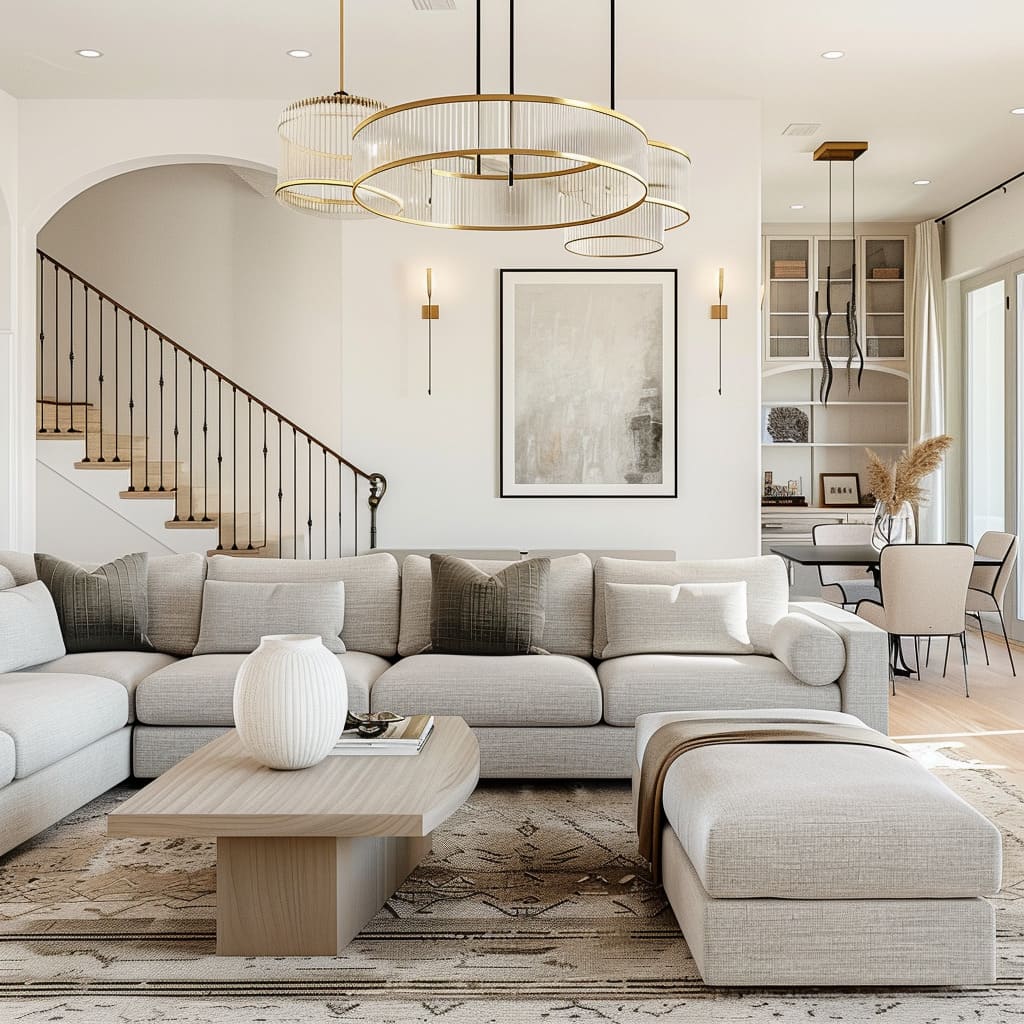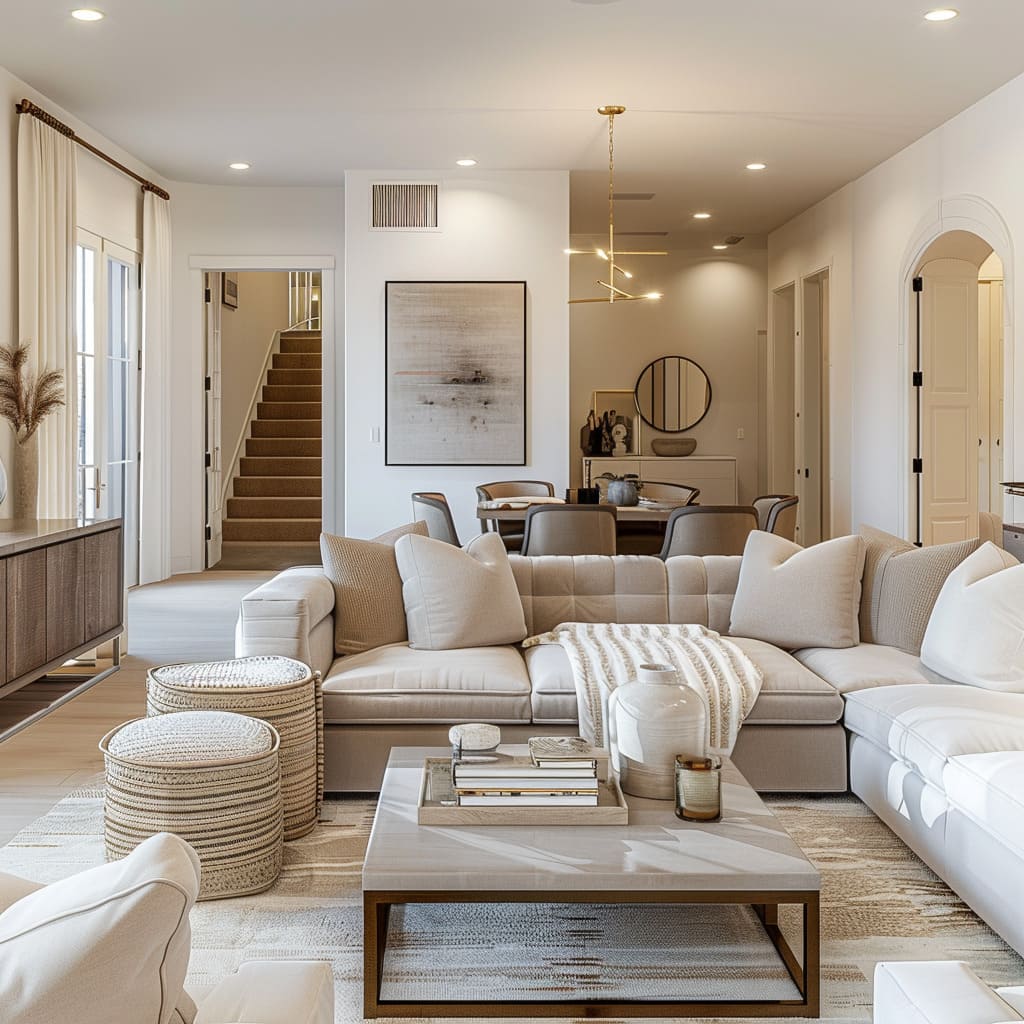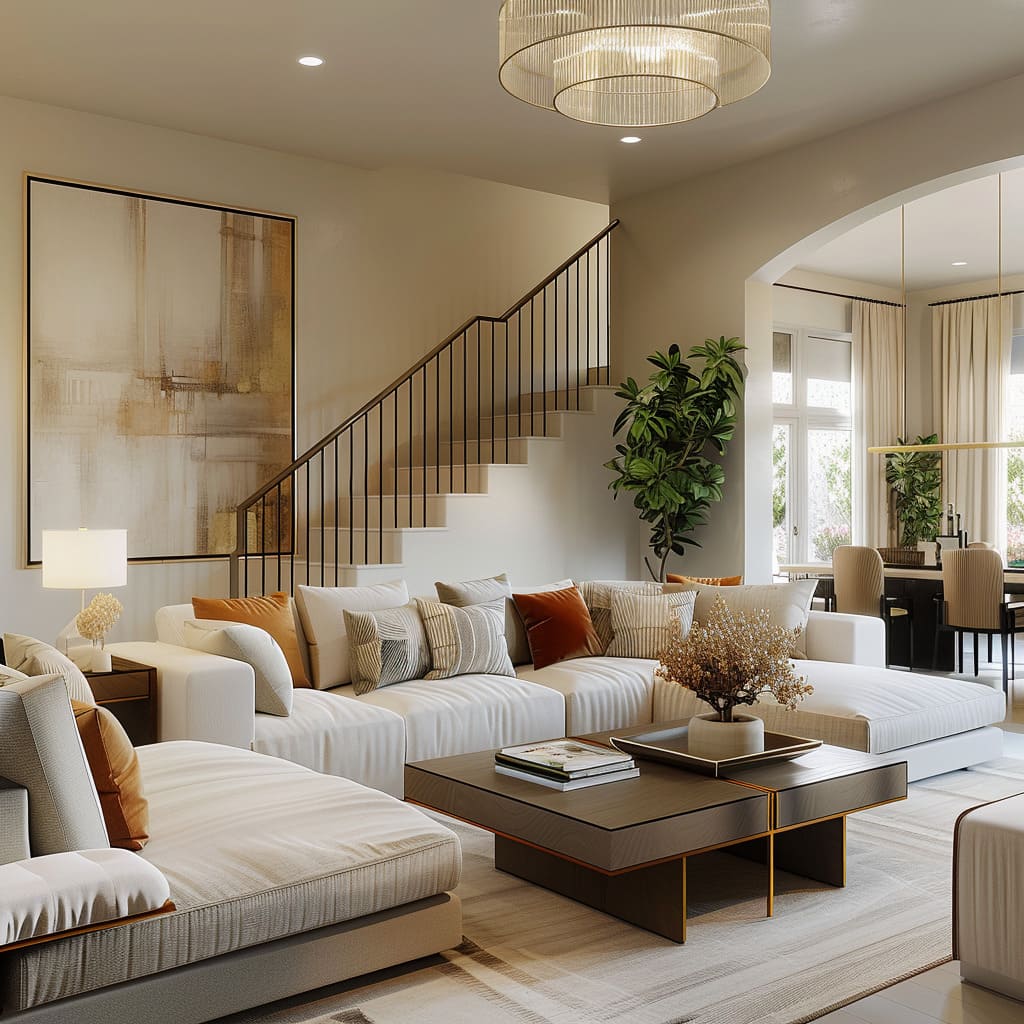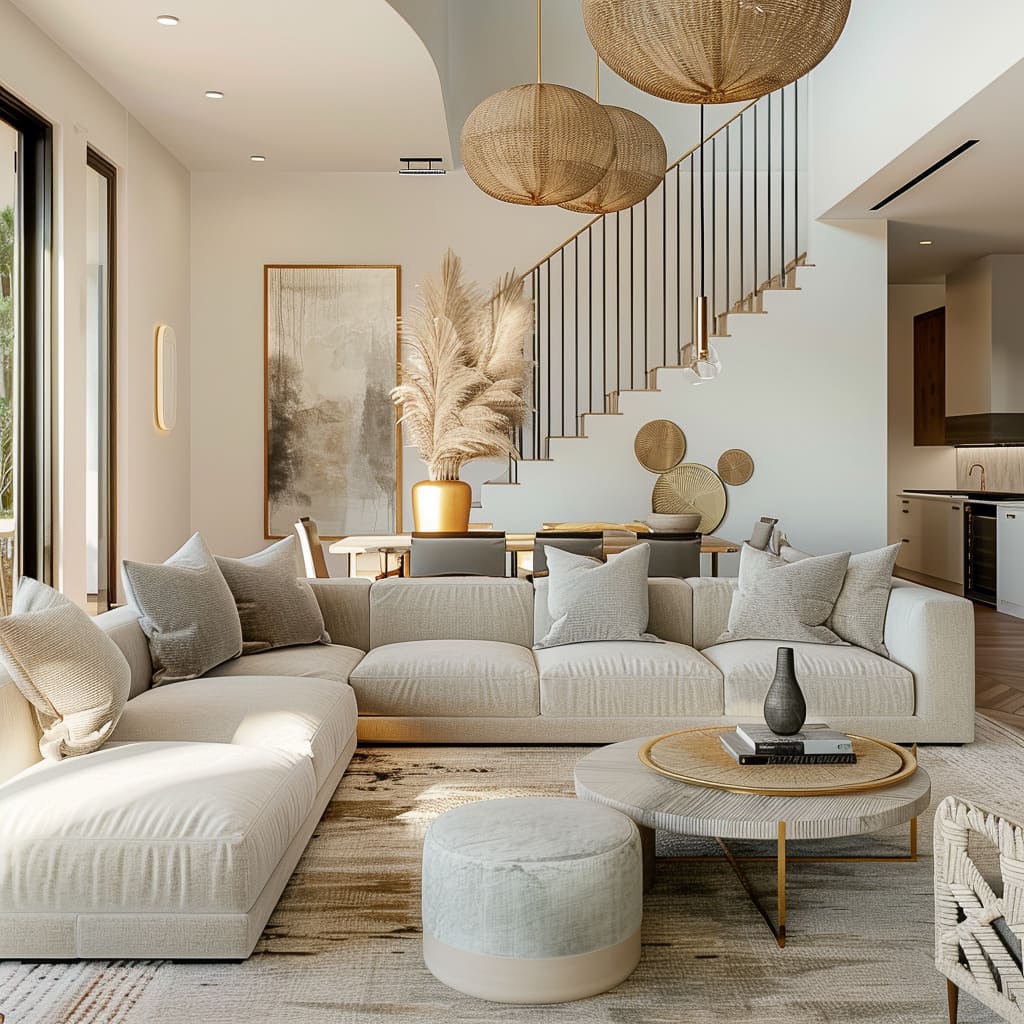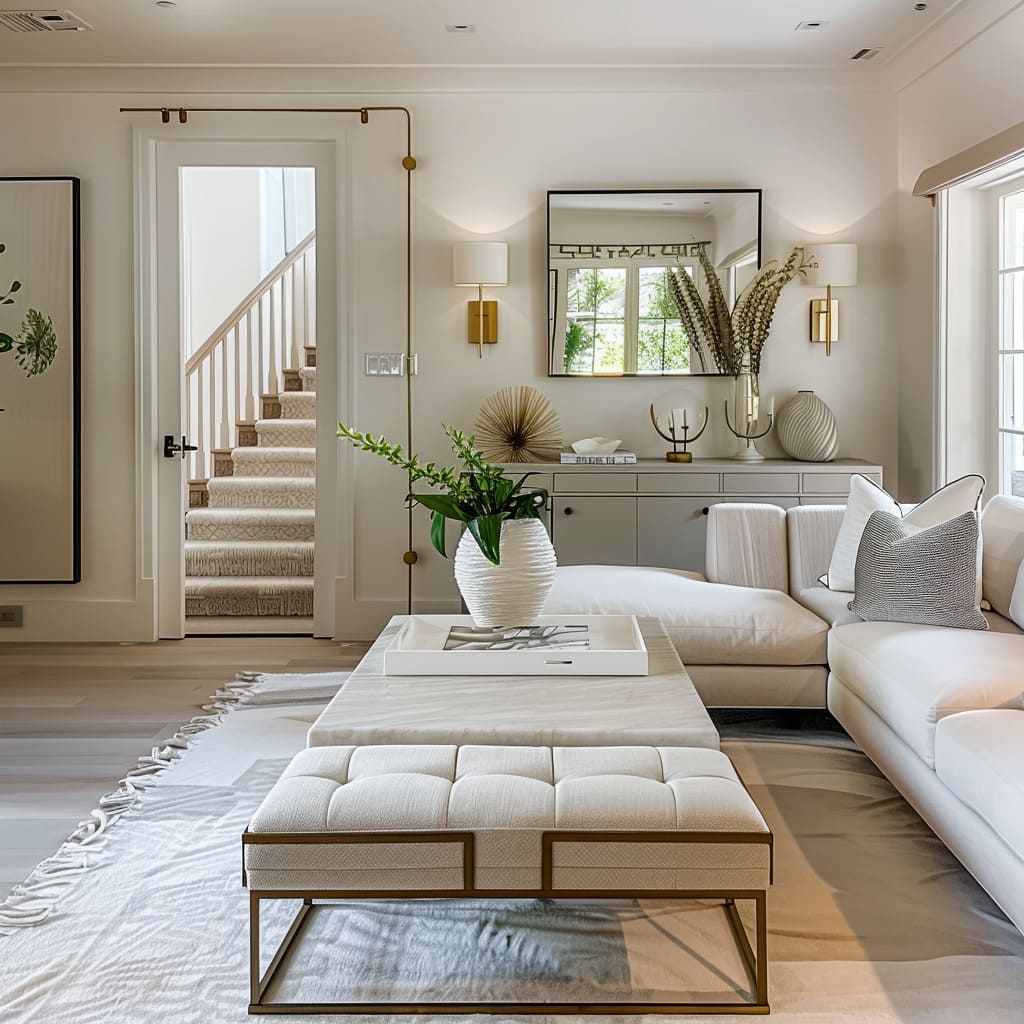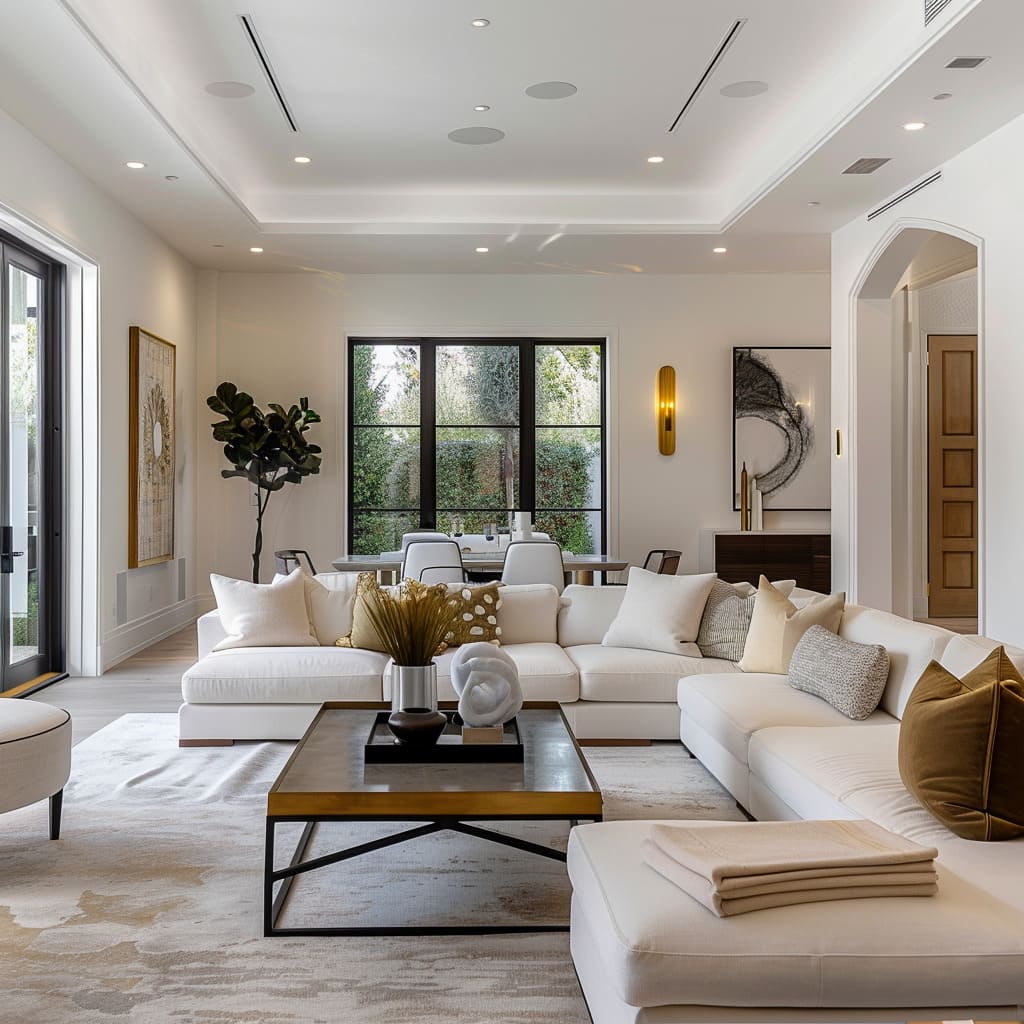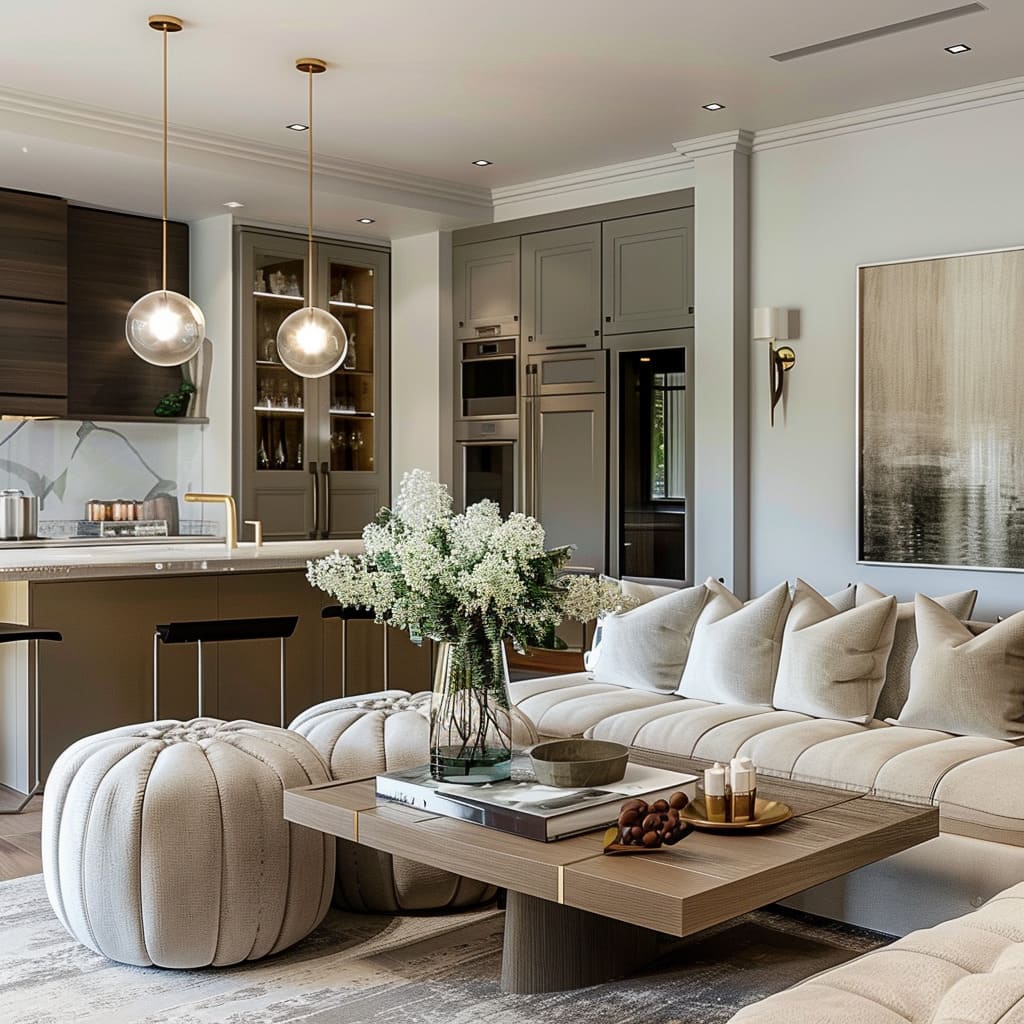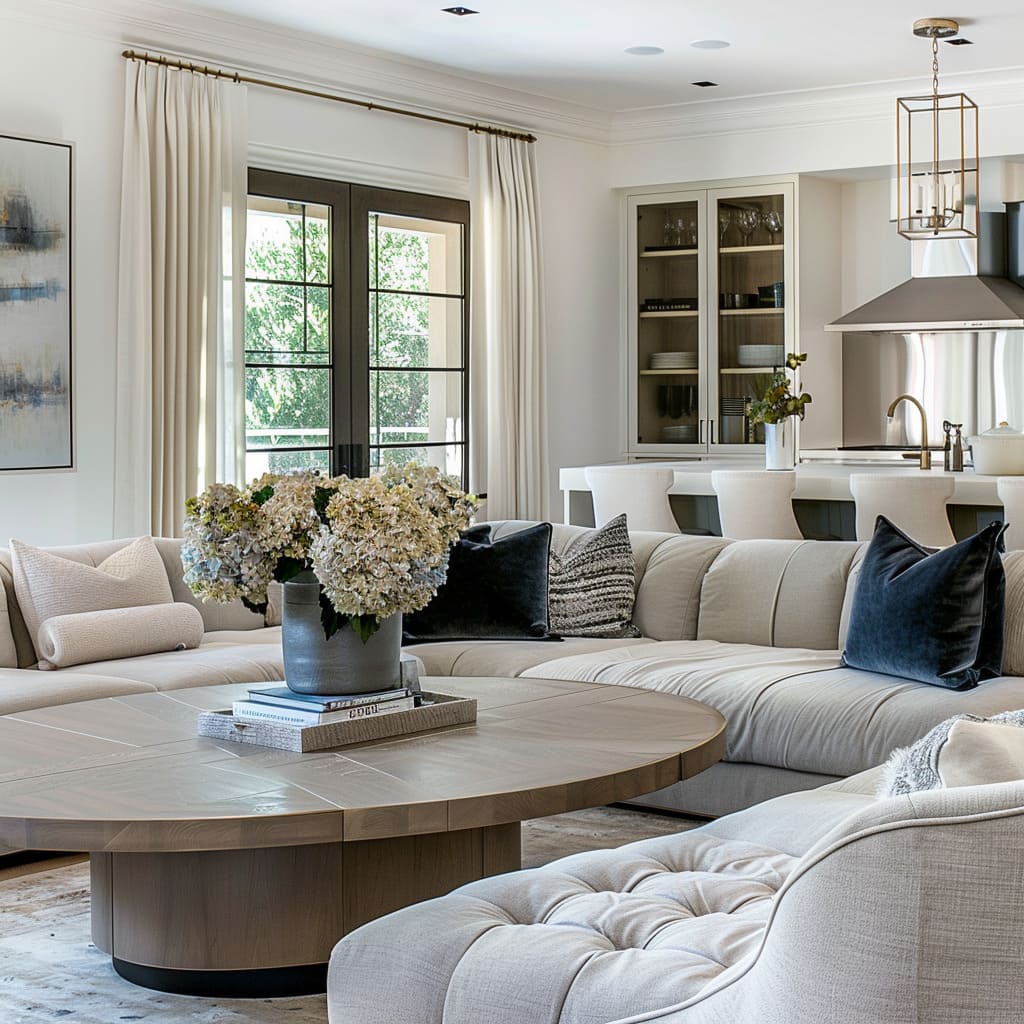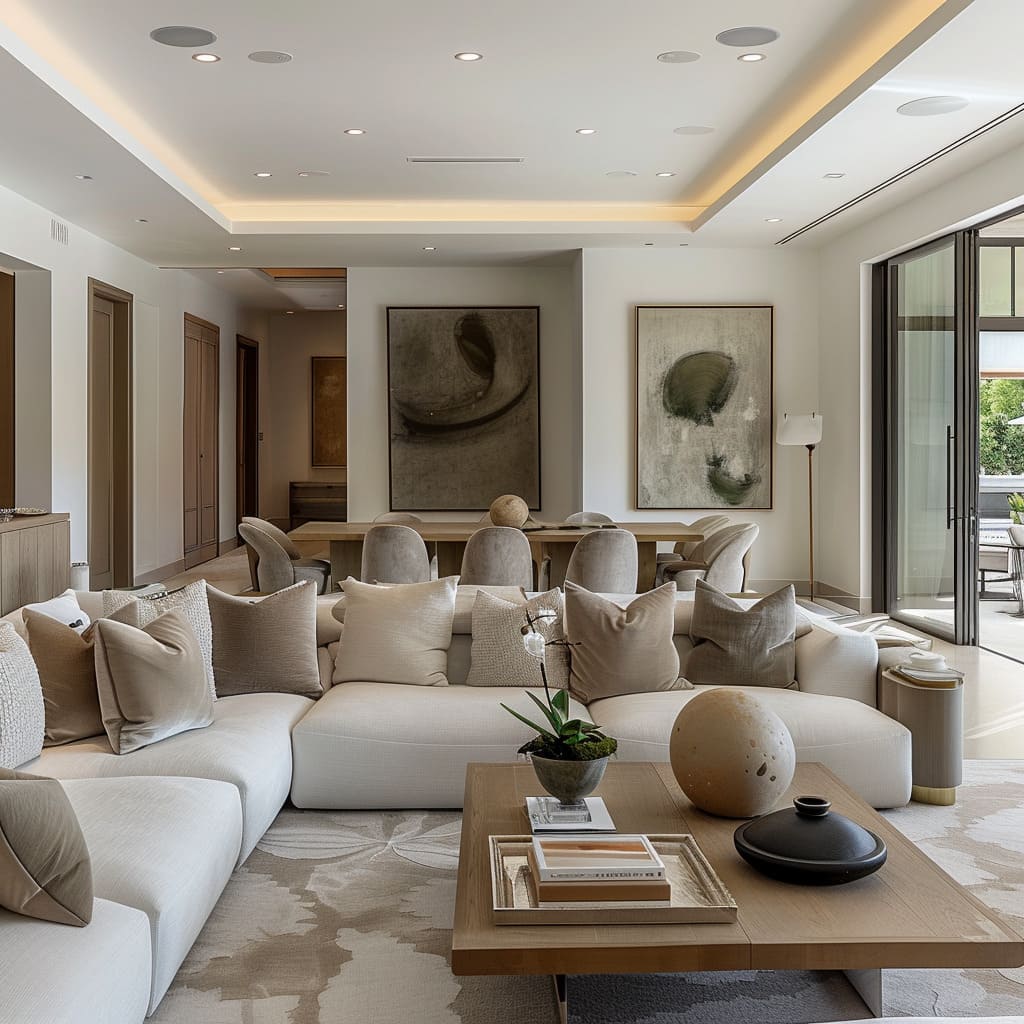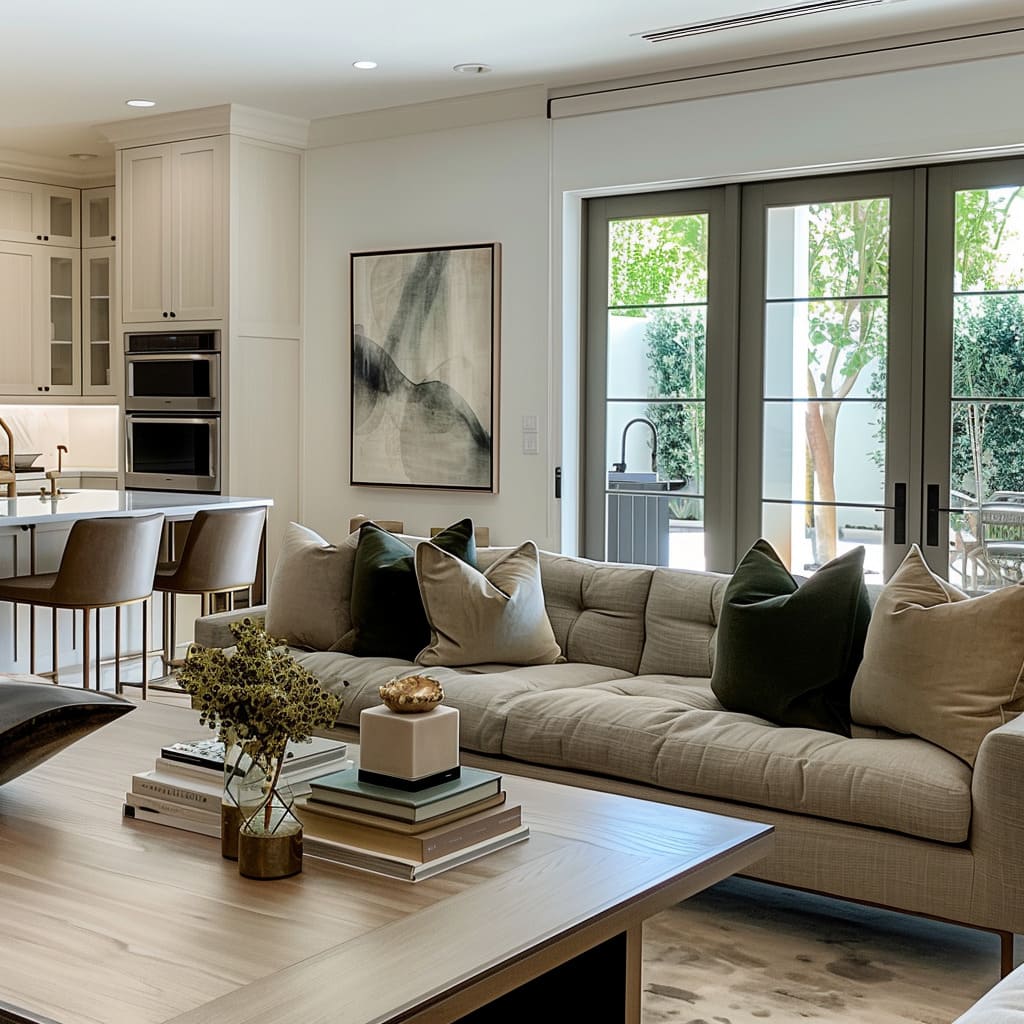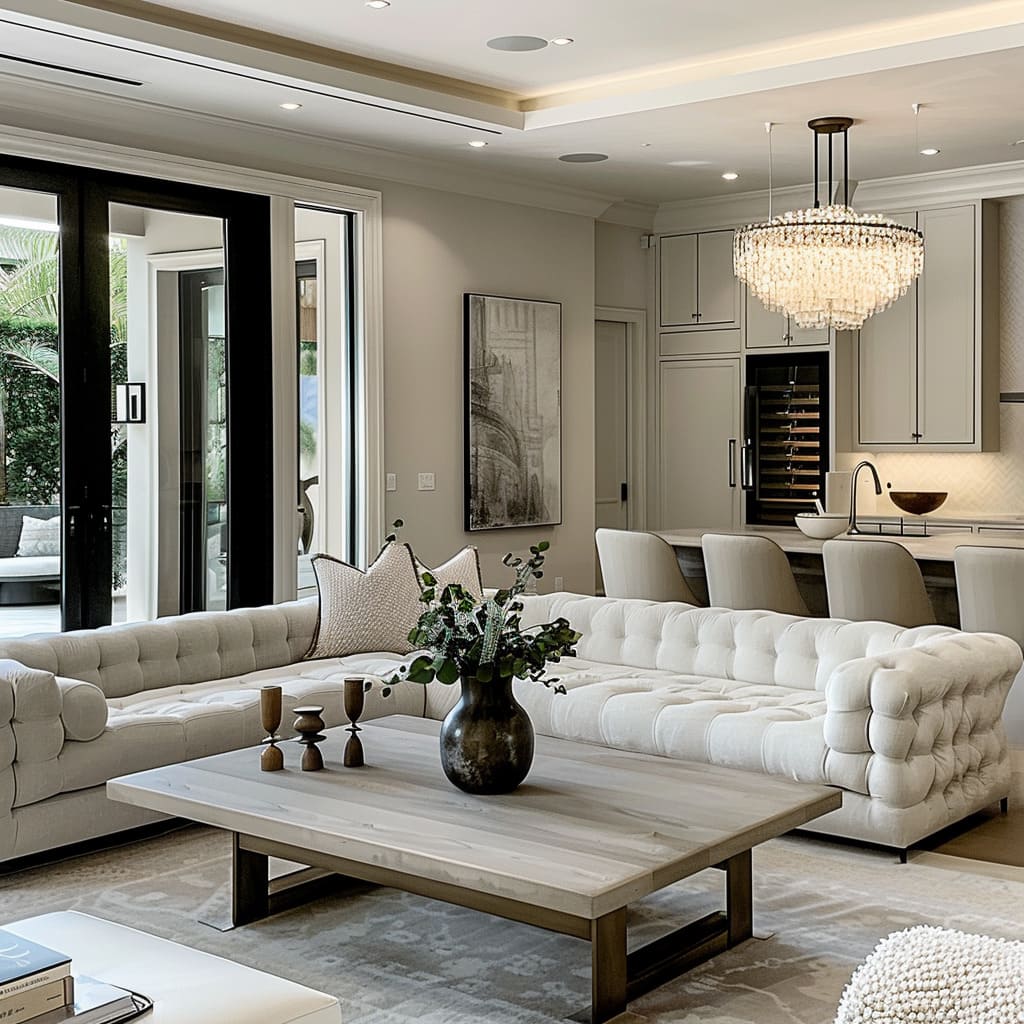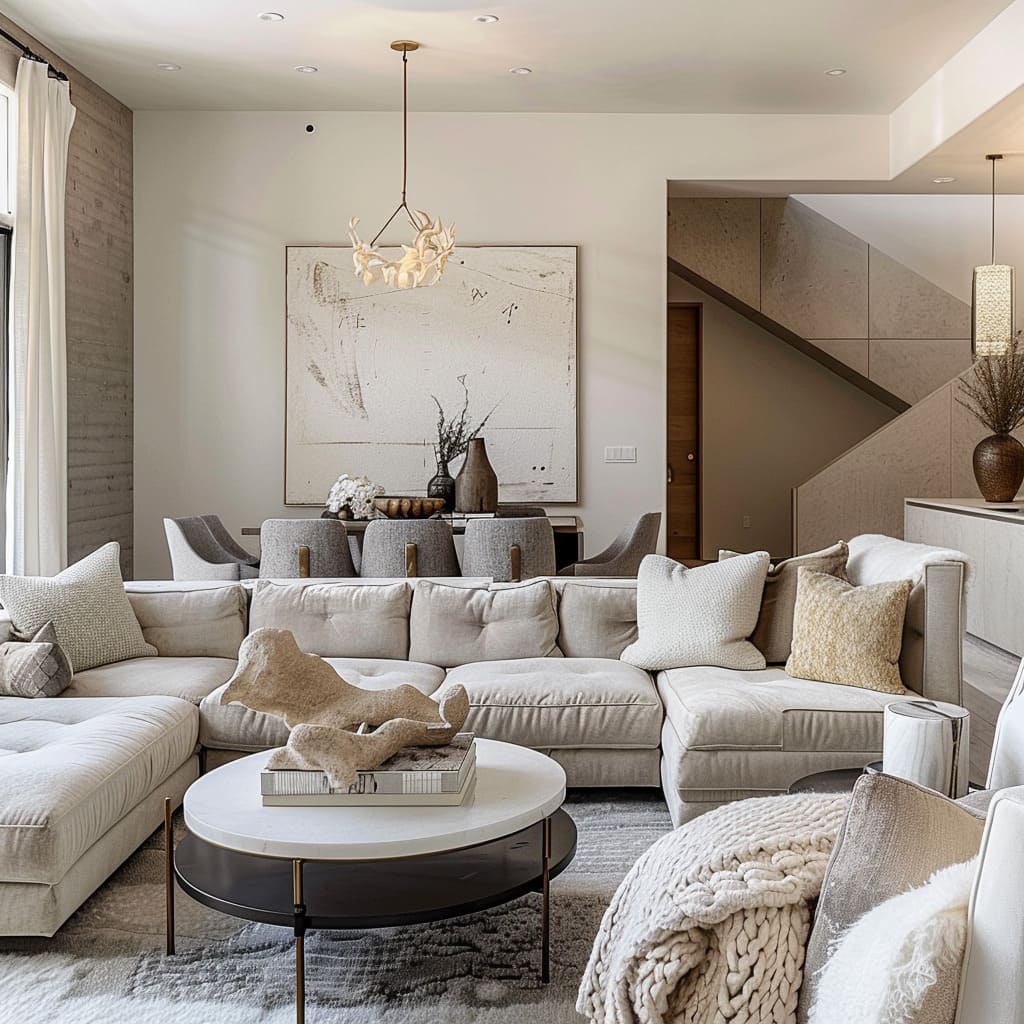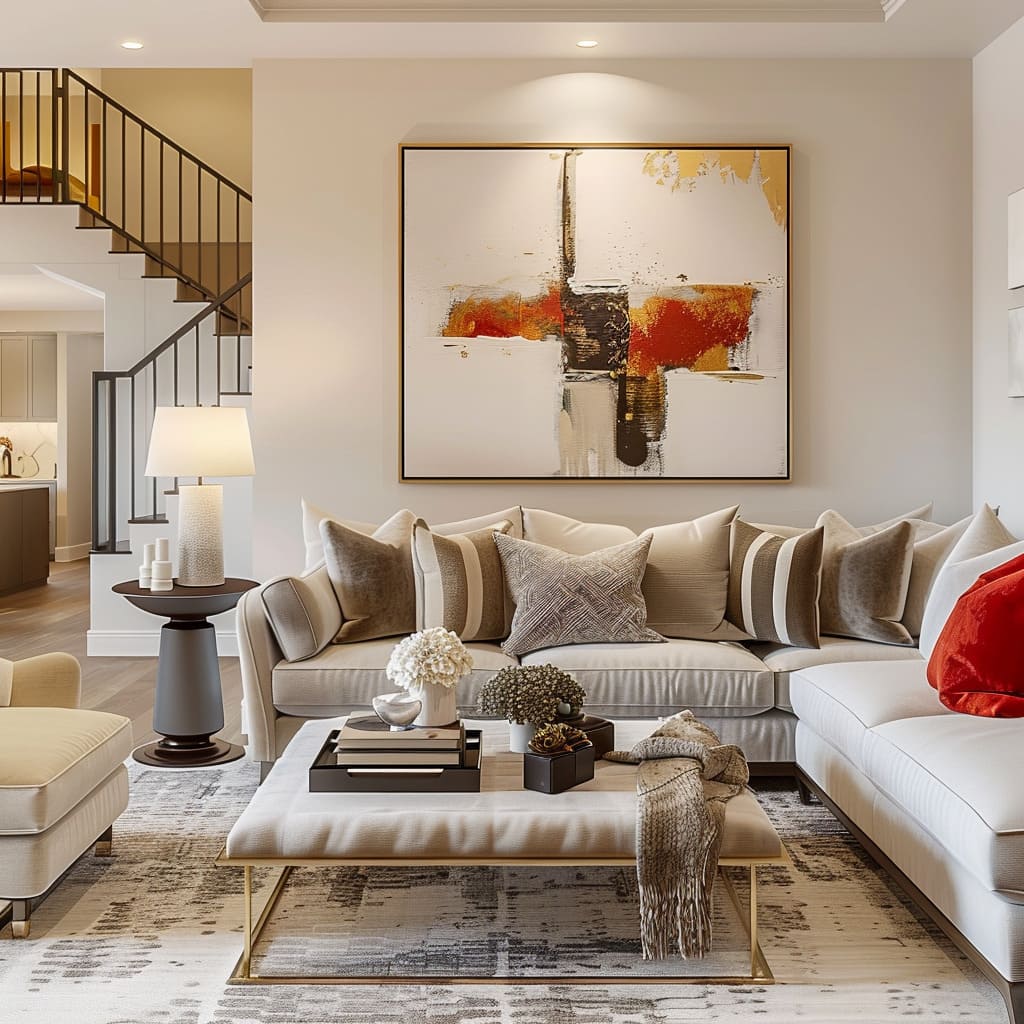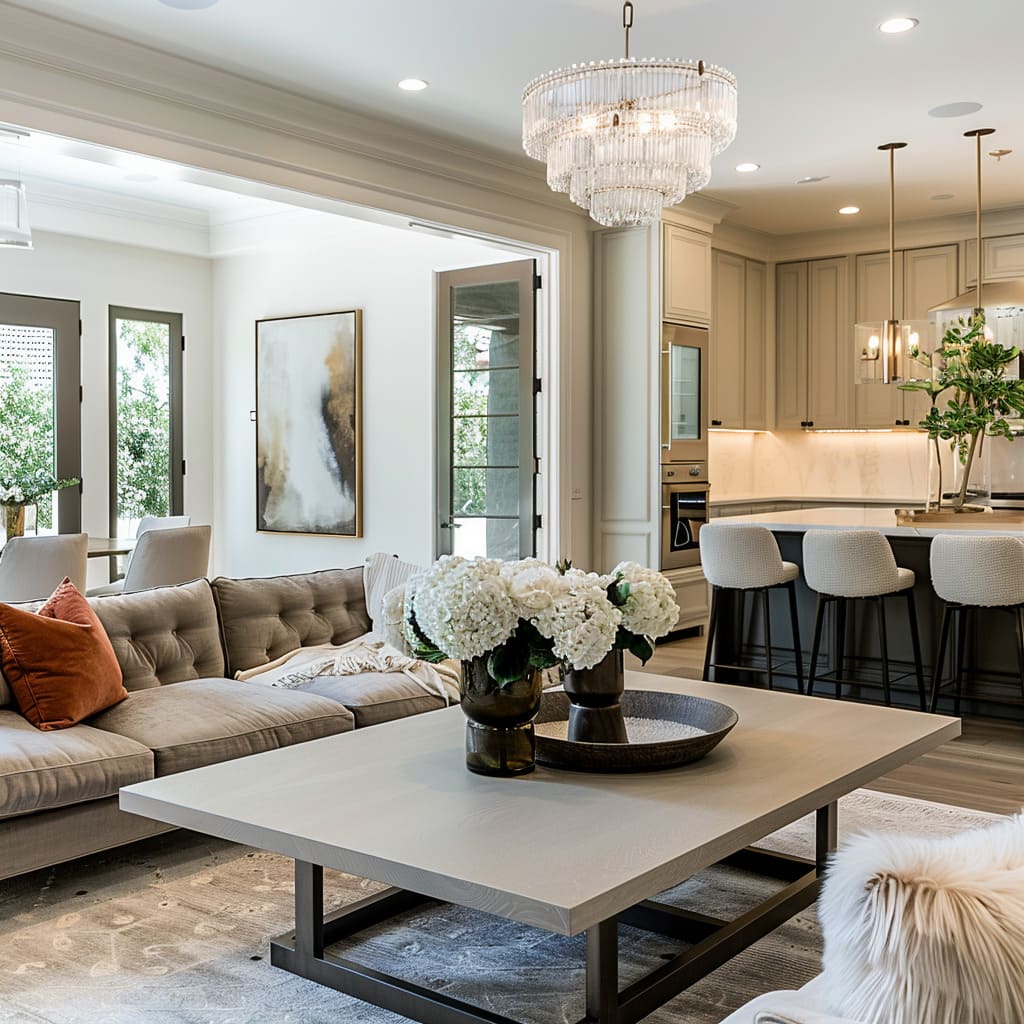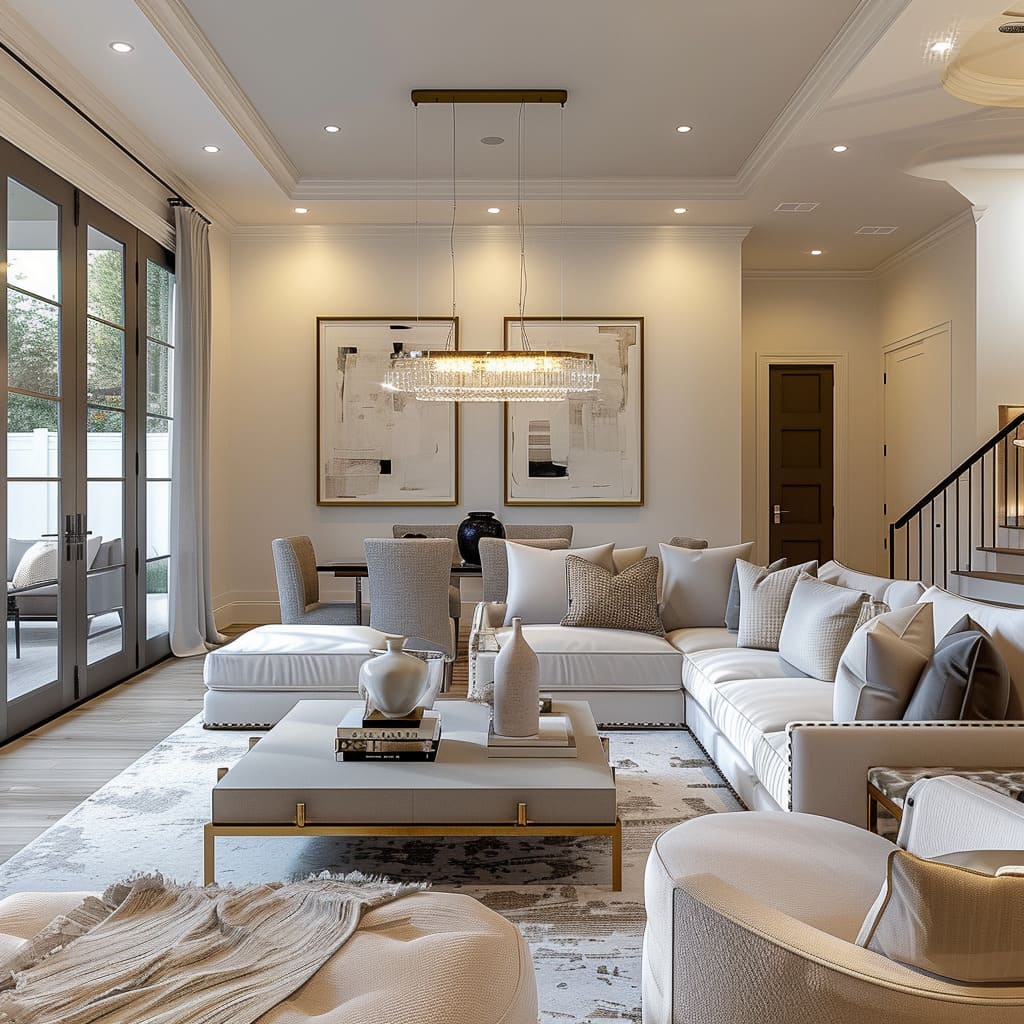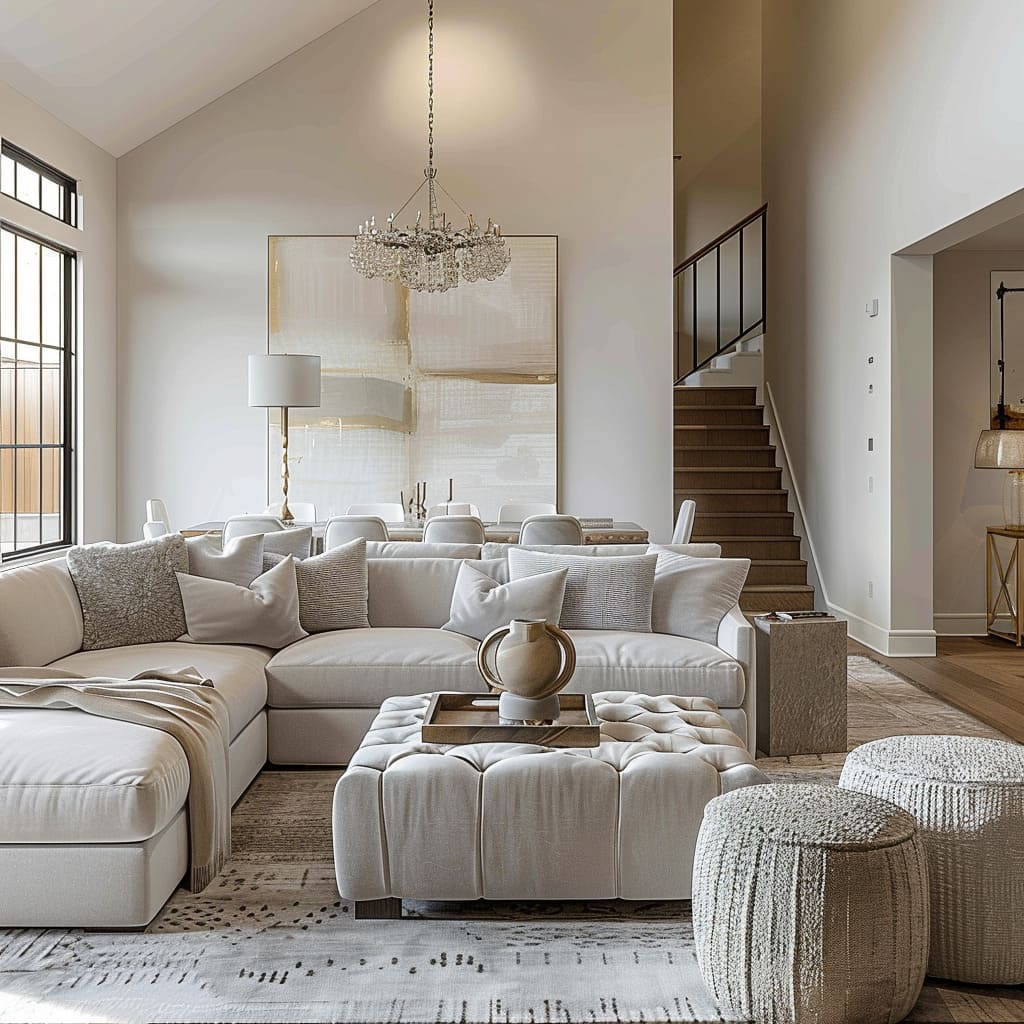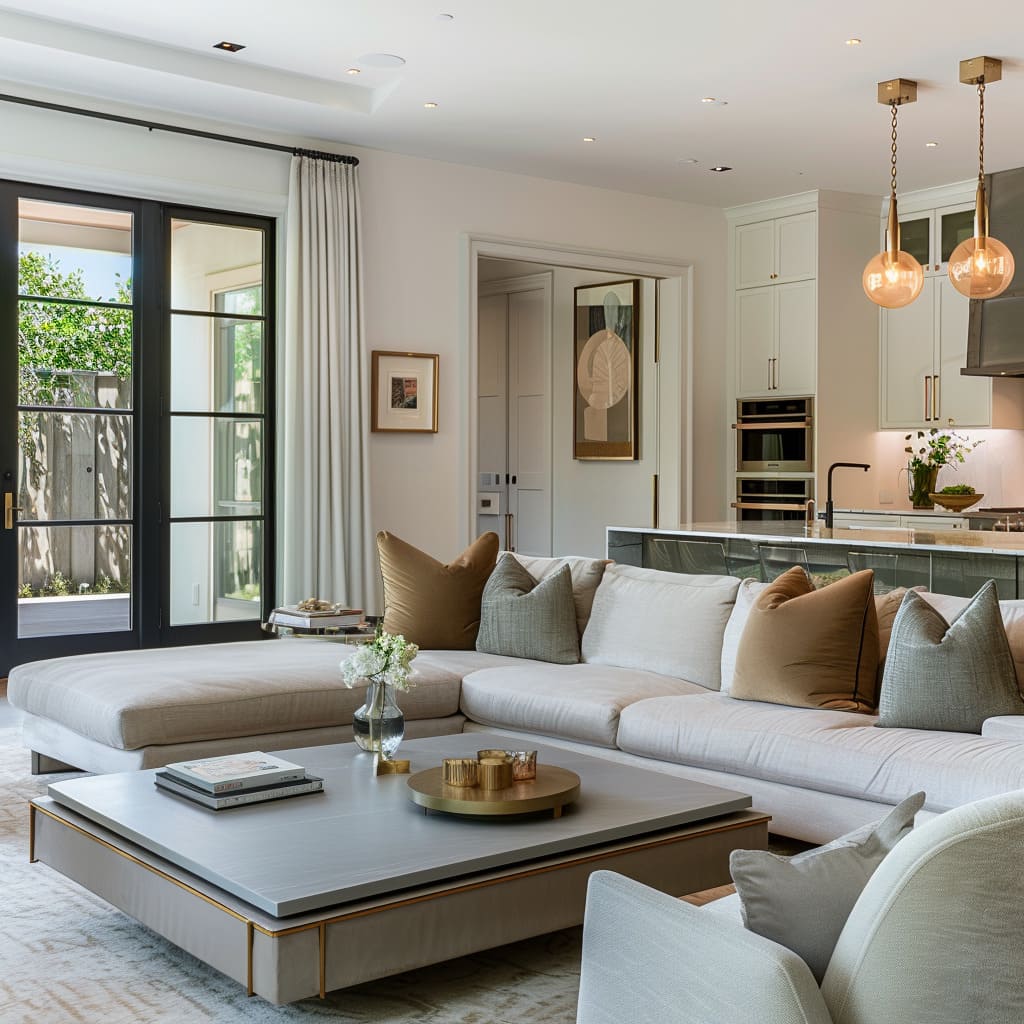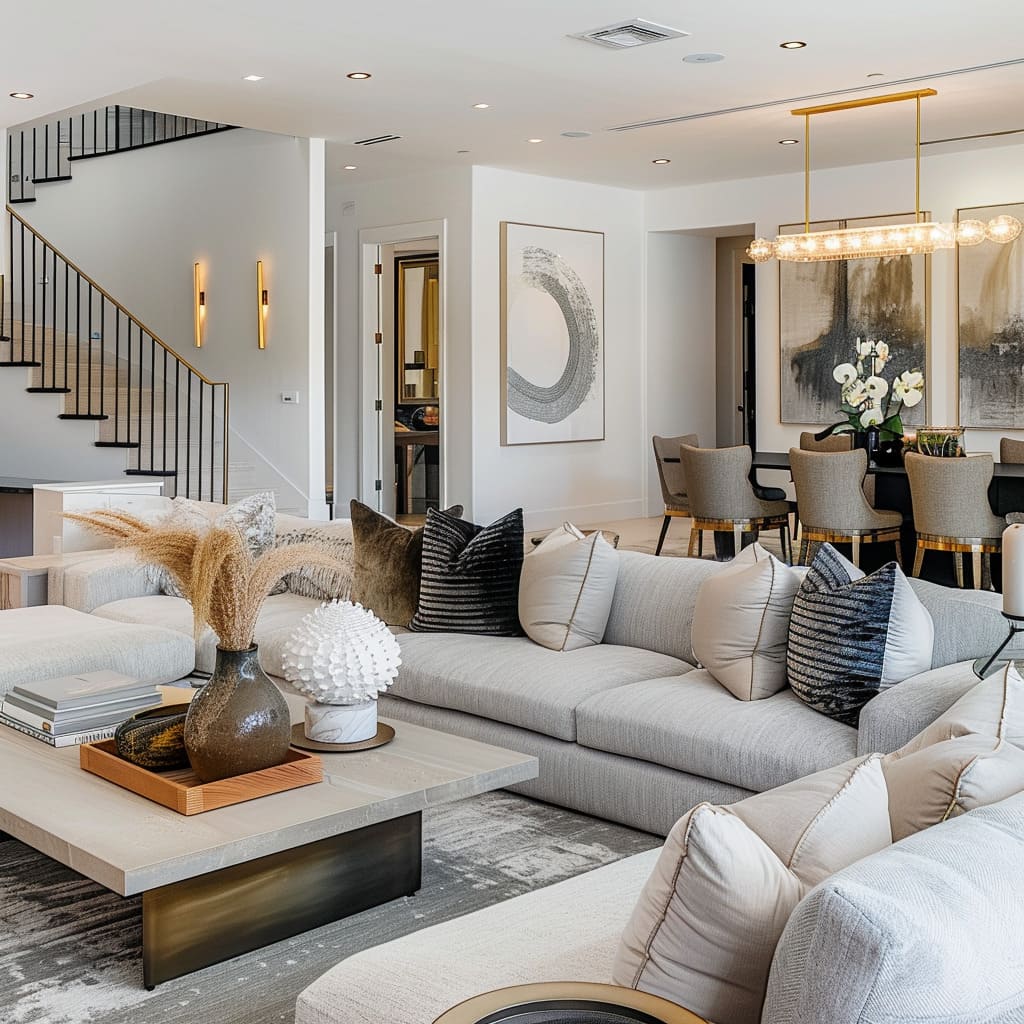The pursuit of tranquility within the walls of our homes has become more essential than ever. This article unfolds the story of interiors crafted not just to shelter, but to shape the quality of our daily lives.
It speaks to a design philosophy that intertwines function with serenity, craftsmanship with comfort, and innovation with environmental consciousness. From the foundational elements that construct a space’s character to the subtle nuances that define its mood, every aspect of the design is a conscious choice that contributes to a holistic living experience.
Harmonious Foundations
Creating spaces that resonate with coherence and order, the design ethos begins with a commitment to a seamless blend of form and utility. This foundation sets the stage for interiors that embody a sense of calm and composure through consistent themes and masterful construction.
Here, the precision in craftsmanship is not merely a function of aesthetics but a testament to the enduring quality and intentionality that define the space.
Streamlined Functionality
The interiors are characterized by a fluid integration of function into every aspect of the design. Furnishings not only accommodate the necessities of daily life but do so with an understated grace.
Tables, chairs, and sofas are not mere objects within a room; they are the subtle enablers of comfort and utility. This functionality extends to the very fabric of the interior, where every fixture and fitting has its place, purpose, and narrative within the grander scheme.
Consistency in Design
As one traverses through the spaces, a story unfolds — one of uniformity and design integrity. Wall art, while diverse in subject, shares a cohesive palette that compliments the understated grandeur of its surroundings.
Every room, while distinct in purpose, carries a common thread in its design language, making the transition from one to another as harmonious as a well-composed symphony. This consistency is the thread that weaves through the fabric of the interior, creating a comforting predictability that calms the psyche.
Precise Craftsmanship
The joinery on display is not merely the meeting of two materials; it speaks of the time-honored skills passed down through generations. In the aligning of wood grains and the precision of a miter joint, one sees a celebration of artisanal heritage.
The smoothness of a tabletop, the soft close of a drawer, the perfect alignment of a bookshelf — each is a tribute to the carpenter’s art. This is craftsmanship that doesn’t scream for attention but instead whispers of its presence through flawless execution.
Balance of Proportions
In this thoughtfully curated space, each piece of furniture exists in dialogue with its counterparts, maintaining a visual equilibrium that is both pleasing to the eye and calming to the spirit.
The placement of sofas in relation to coffee tables, the spacing of chairs around a dining table, and the height of lamps in relation to seating — all are calculated with an intrinsic understanding of scale and spatial relationships. This balance ensures that the space is neither overcrowded nor sparse, but perfectly attuned to human movement and interaction.
These foundational characteristics come together to create an interior that speaks of understated sophistication and a timeless sense of style. They are the underlying principles that set the stage for a living experience that is both aesthetically pleasing and deeply functional.
Through a meticulous orchestration of form, function, consistency, and proportion, these spaces offer a sanctuary that is both invigorating and restful.
Visual and Tactile Delicacy
An environment’s essence is often captured in the subtleties – the understated interplays that engage the senses without overwhelming them. This section explores the deft use of textures, colors, and materials that maintain a delicate visual weight and composure.
Here, the art of design is expressed in the gentle nuances that enrich the experience of the space.
Subtle Textural Interplay
Within this design framework, the interplay of textures offers a sophisticated dance of surface experiences. Soft weaves partner with smooth ceramics and the occasional roughness of a natural fiber rug to add dimension without discord.
The couch’s plush might be juxtaposed with the sleekness of a metal lamp base, engaging the sense of touch as a canvas would to the painter’s brush. The consistency of color throughout these varied textures ensures that the visual narrative remains uninterrupted.
Visual Weight Distribution
A balanced distribution of visual weight lends a serene and grounded feeling to the environment. Heavier furniture pieces are complemented by airy accents like delicate glass vases and thin-framed mirrors.
This equilibrium allows for a feeling of expansiveness within the room, where space and furniture coexist without competition. It’s a precise calibration that ensures a room is neither too dense with furnishings nor too sparse, striking an impeccable balance that feels both purposeful and free.
Understated Window Treatments
The windows, dressed in simplicity, do more than frame the view to the outside world; they serve as a backdrop to the life unfolding within the space. The curtains fall with a weight that speaks of quality, yet their design does not demand attention, allowing the eyes to appreciate the beauty beyond the panes.
They control light with a soft hand, complementing the room’s ambient glow rather than obscuring the natural illumination.
Selective Use of Color
The use of color in these spaces is not haphazard but chosen with a curator’s eye. Neutral tones serve as a canvas for splashes of color that act as visual exclamation points, drawing the eye with intention.
A blue throw here, a burgundy pillow there — each is a note in a greater symphonic composition, adding depth and resonance to the room without disturbing its peaceful rhythm.
Conservative Use of Pattern
The application of patterns is a subtle affair, with designs that whisper rather than shout. The rugs might bear a discreet chevron, the upholstery a faint herringbone.
These patterns do not fight for attention but serve to enhance the overall composition, giving it a gentle complexity that rewards the careful observer. This conservative approach to pattern ensures a timeless appeal that transcends fleeting trends.
Discrete Color Accents
Color accents are like the final brushstrokes on a painting, placed with precision and thought. They are found in objects that tell stories — the ochre of a pottery vase, the deep green of a decorative bowl — adding narrative threads to the space.
These accents offer an easy adaptability, ensuring that the interior can evolve with the seasons or according to the whims of its inhabitants, without the need for complete redesign.
Together, these facets of design combine to create interiors that are not only visually appealing but also tactilely rich, engaging all senses with subtlety and intention. They reflect a keen understanding of how humans interact with space, making each encounter with the environment a pleasing one.
It’s an approach that values understatement and refinement, creating rooms that are sanctuaries of visual and tactile delight.
Spatial Rhythm and Sensory Comfort
The rhythm of a space is orchestrated through the strategic arrangement of elements that guide movement and sight, creating an effortless flow. This rhythm is complemented by the tactility of surfaces and materials, inviting touch and comfort, ensuring that the space is not just seen but felt, promoting a sense of well-being and tranquility.
Intentional Whitespace
The intentional use of whitespace in these interiors goes beyond mere absence of color or ornamentation. It is a strategic design choice that elevates the room’s aesthetic, giving a visual pause and creating breathing room between elements.
This sense of openness is not accidental but a deliberate move to foster a tranquil atmosphere where the mind can wander freely without visual obstruction. Here, spaces are not filled for the sake of appearance but are allowed to embrace the beauty of unadorned simplicity.
Visual Flow
The carefully considered placement of furnishings facilitates an effortless journey through each room. Seating is arranged not just for conversation but also to afford easy passage, ensuring that movement within the space feels intuitive and unforced.
The clear pathways and the orientation of furniture also serve to highlight focal points, whether a stunning fireplace or a piece of captivating wall art, drawing the gaze naturally and without abrupt redirection.
Tactile Comfort
The tactile experience in these rooms is as carefully curated as the visual. Textiles are chosen not just for their color or pattern but for the way they feel against the skin.
Plush cushions beckon, offering an invitation to relax, while the upholstery of seating melds comfort with durability. Even the floors lend themselves to the sensory experience, with rugs that are a pleasure to walk upon, reinforcing the ethos of comfort in every touchpoint.
Soft Illumination
The lighting within these spaces does more than illuminate; it sets the tone. Lamps with frosted glass shades cast a glow that softens the edges of the day, while overhead lighting is placed to highlight the room’s best features without becoming obtrusive.
It’s lighting that complements the time of day and mood, with dimmers that allow for the ambiance to be adjusted on a whim. It’s about creating an environment where light is not just seen but felt, contributing to the space’s overall warmth and allure.
These elements, when woven together, create an interior that is more than the sum of its parts. It’s a symphony of space, comfort, and light, playing out in rooms designed not just to be seen but to be experienced.
It’s an approach that understands that the true essence of a home is not in how it looks when you first step inside, but how it feels when you sink into a chair at the end of a long day. It is, at its core, a sanctuary of sensory delights, a retreat from the world where every element is aligned with the rhythms of rest and relaxation.
Integrated and Subtle Enhancements
Functionality extends to the integration of technology and the intelligent use of space. This section delves into the ways design seamlessly incorporates modern conveniences while maintaining a clean and unobtrusive aesthetic.
The focus on vertical space and the fluid transition between areas amplifies the spatial quality without sacrificing comfort or sophistication.
Inconspicuous Technology
In this modern age, the presence of technology in our living spaces is a given, yet its integration within these interiors is so subtle it nearly becomes invisible. Devices that support daily life are cleverly concealed within the furnishings or behind discreet panels, ensuring that they don’t interrupt the visual serenity of the space.
Screens blend into wall units, and speakers are tucked away, only making their presence known when called upon. This seamless incorporation of technology ensures that the living space adapts to modern needs without compromising on style.
Fluid Transitions
As one navigates through these spaces, there’s an unmistakable fluidity that allows for a graceful transition from one area to the next. Doorways and passageways are designed to feel like natural extensions of the rooms they connect.
Floor materials change with a subtlety that respects the purpose of each area while maintaining an overarching sense of unity.
The manner in which the kitchen flows into the dining area or the living room opens to the outdoor space exemplifies a design philosophy that honors the natural progression of movement and life within the home.
Focus on Vertical Space
The design not only honors the footprint of the space but also its vertical ascent. Ceilings are not forgotten planes but areas of interest, with lighting fixtures that draw the eye and add to the room’s character.
The walls are punctuated with art or shelving that reaches upwards, inviting a gaze to wander and appreciate the volume of the room.
This attention to the vertical dimension enriches the spatial narrative, offering a sense of grandeur and openness that elevates the everyday living experience.
These thoughtful enhancements converge to create a living environment that’s not just up-to-date with the times but also anticipates the future. They do so while maintaining an aesthetic of seamless design, where the space itself becomes a canvas for life’s most precious moments.
It’s a blend of foresight and finesse that marks these interiors as places where life’s complexities are simplified through design, and where the beauty of the space is matched by its intelligent functionality.
Mindful and Restorative Ambience
The final section envelops the concepts of environmental mindfulness and the creation of a sanctuary. It speaks to the importance of designing spaces that not only exist in harmony with their natural surroundings but also serve as a restorative backdrop for the individuals who inhabit them.
Through sustainable practices and a focus on creating a relaxed atmosphere, these design choices mirror a contemporary consciousness that values both the planet and personal well-being.
Relaxed Ambiance
In these spaces, a tranquil atmosphere prevails, where calm is not an afterthought but a fundamental feature of the design. The colors, materials, and very air seem to whisper an invitation to unwind.
Furnishings don’t just occupy space; they beckon one to linger, to engage in the simple pleasure of stillness. This ambiance is a sanctuary, a gentle reprieve from the outside world, where the pace of life slows, and one is encouraged to savor moments of solitude or intimacy.
Sustainable Choices
The undercurrent of sustainability is both a conscious choice and a subtle statement in these spaces. Materials are selected not just for their aesthetic value but also for their low environmental impact, reflecting a responsibility towards the future.
Wood is not merely a medium but a message of durability and renewal, and the incorporation of living plants isn’t just for beauty but also for the benefits of cleaner air and a connection to nature.
Even the energy solutions are designed to be as unobtrusive as they are efficient, quietly supporting a lifestyle that’s as kind to the planet as it is to the soul.
The essence of these interiors is one where every element conspires to create an environment of peace and harmony. The ambiance encourages a slower pace of life, where one is attuned to the subtle rhythms of nature and the mindful passage of time.
It’s a place where sustainability isn’t just a buzzword but a tangible component of the living space. This mindful approach extends to every corner, every choice, creating a home that is not only a retreat but also a testament to the virtues of living with intention and care.
Concluding this exploration of interior spaces that echo with the silent music of design, we recognize that true beauty in a home comes from a balance struck between its aesthetic appeal and the quality of life it nurtures. These spaces remind us that our environments are not just backdrops to our lives, but active participants in it.
They hold the power to calm, to inspire, and to reflect our values back at us. As we step out from these pages back into the world, we carry with us the understanding that the spaces we inhabit are more than mere structures; they are the sanctuaries of our existence, the places where our simplest moments become our most treasured memories.


